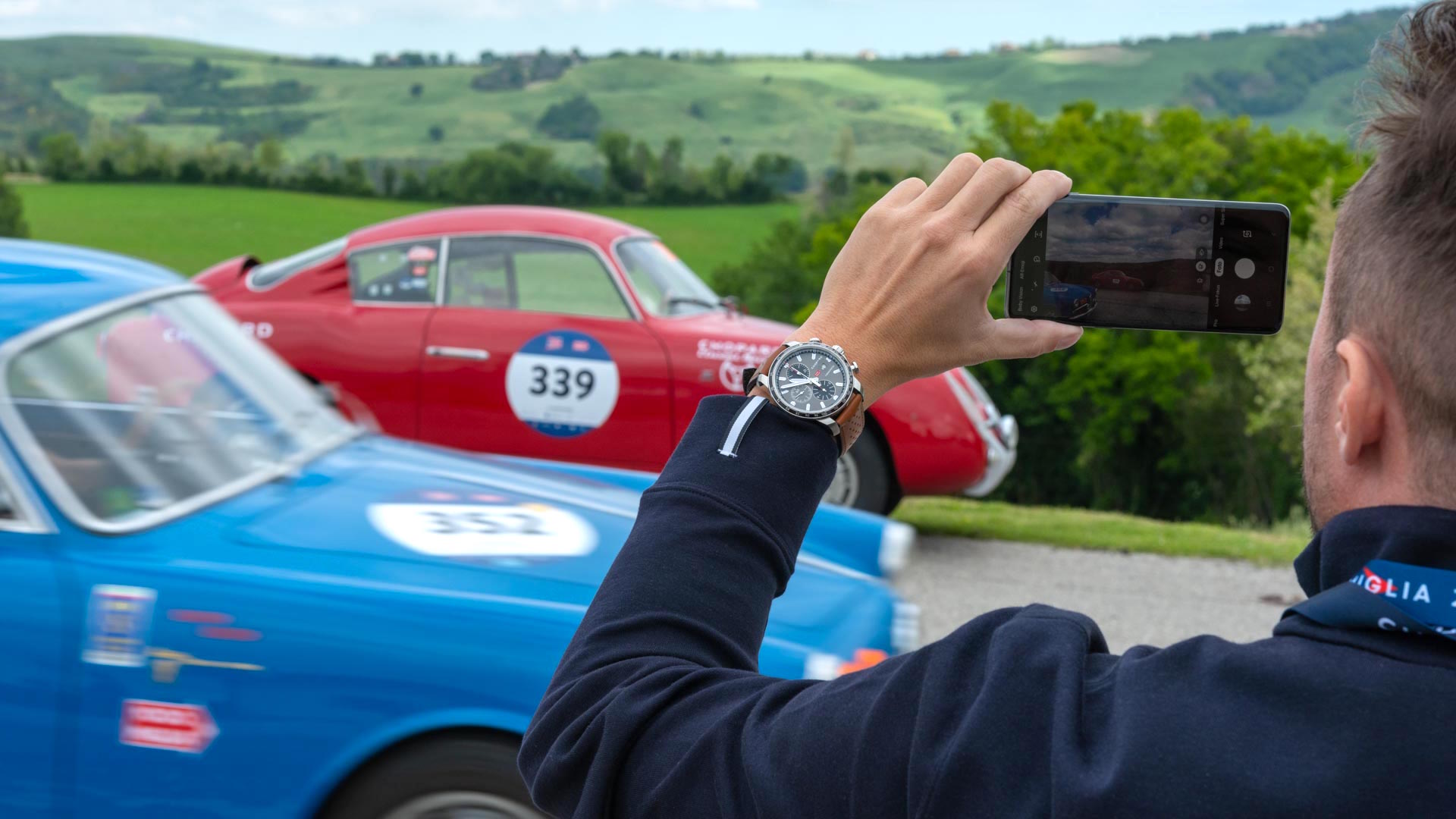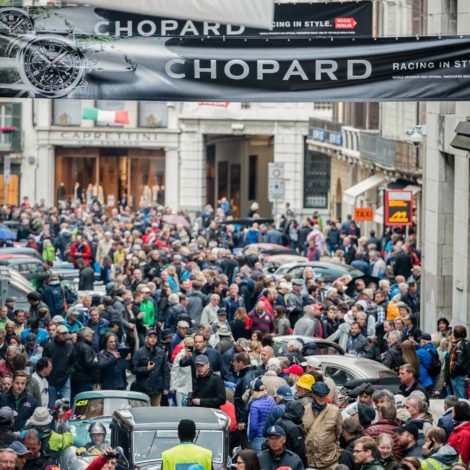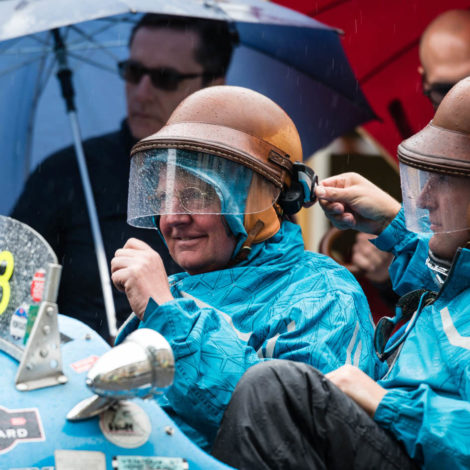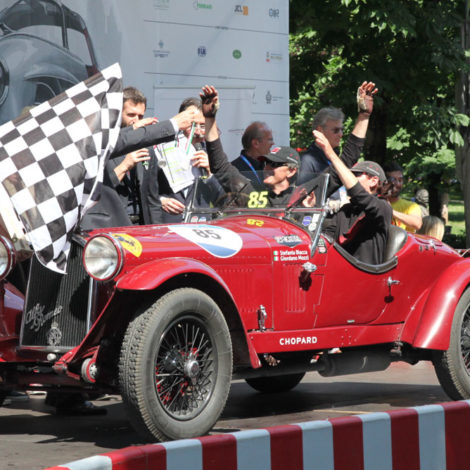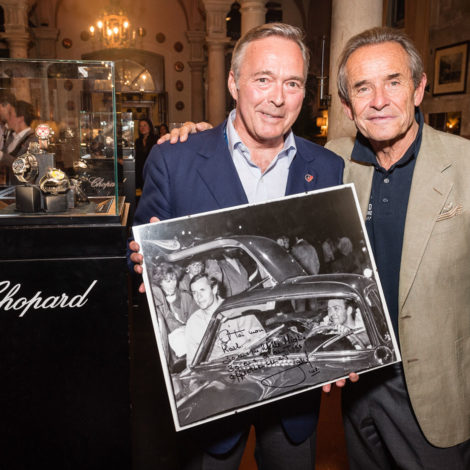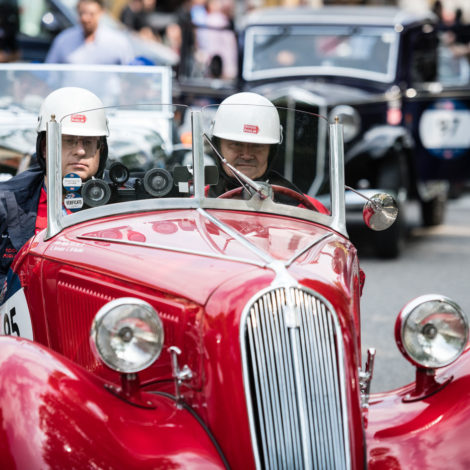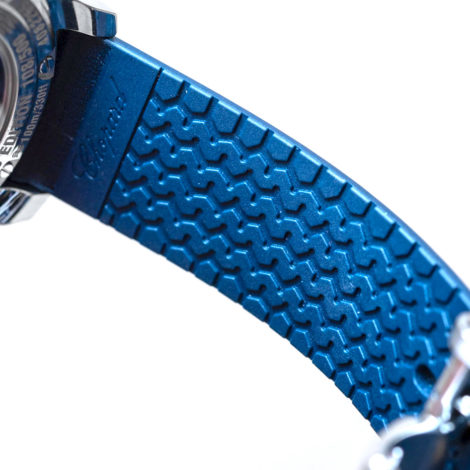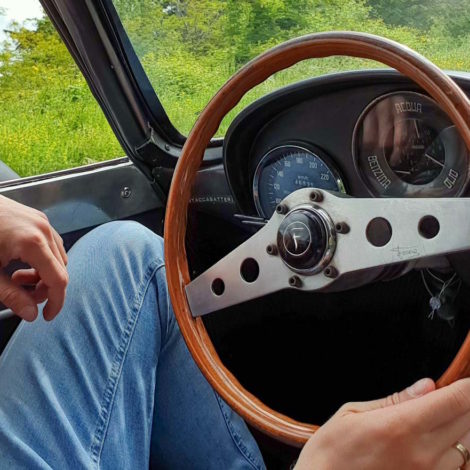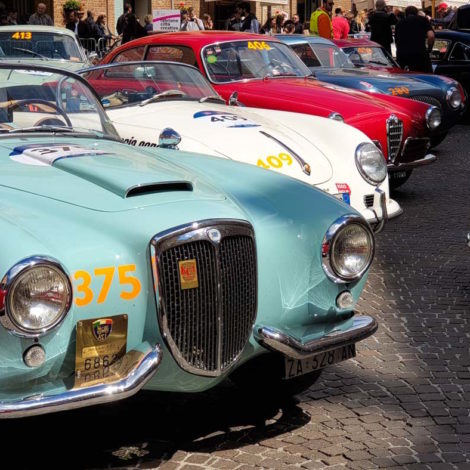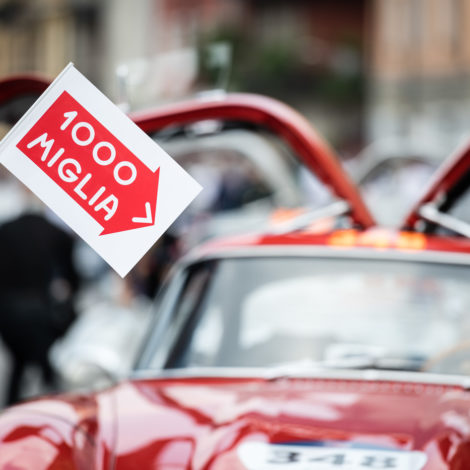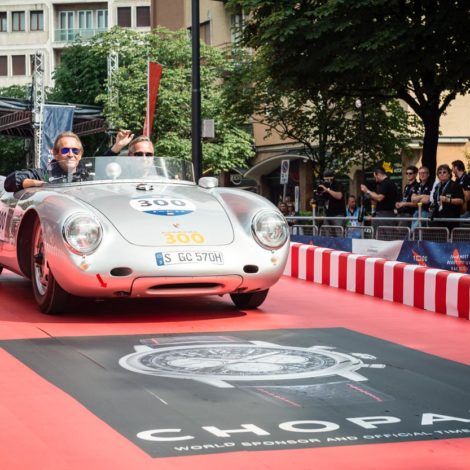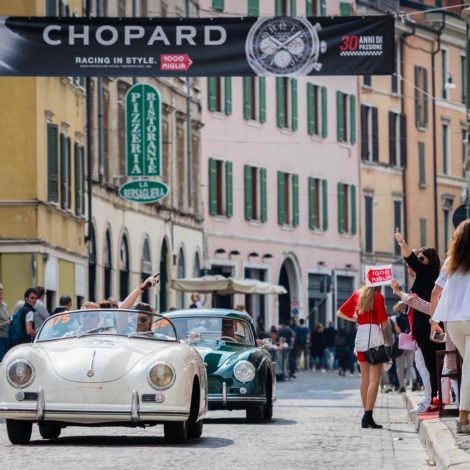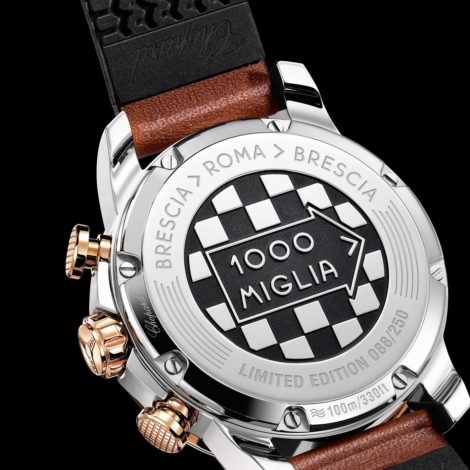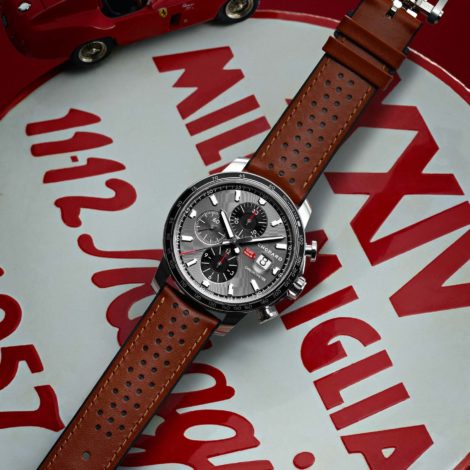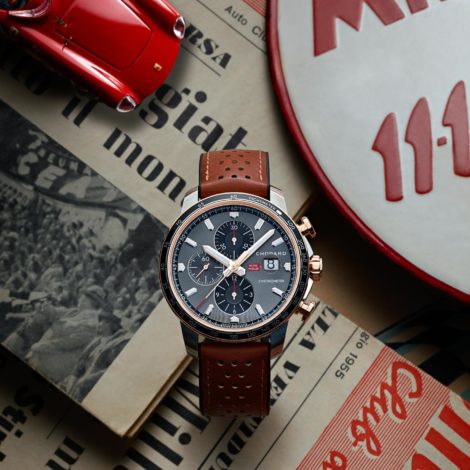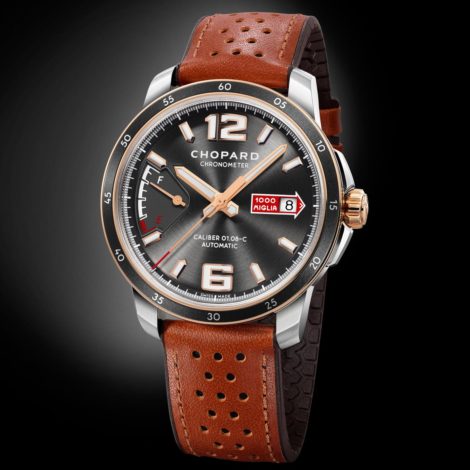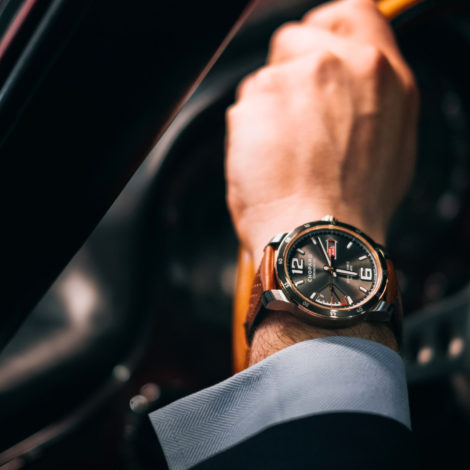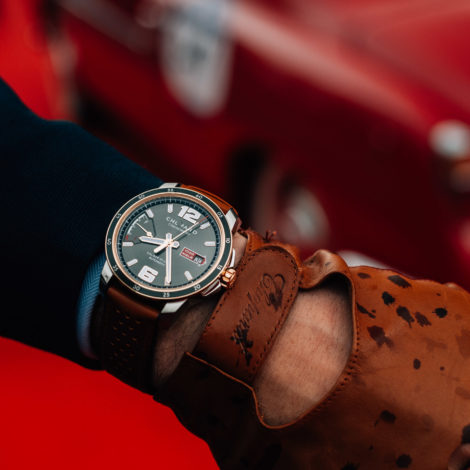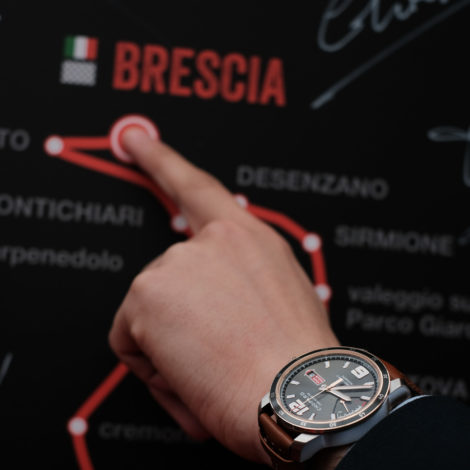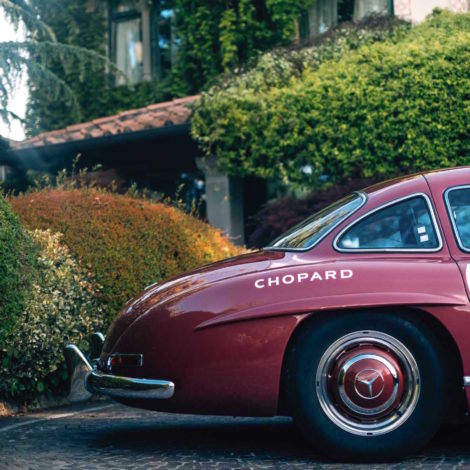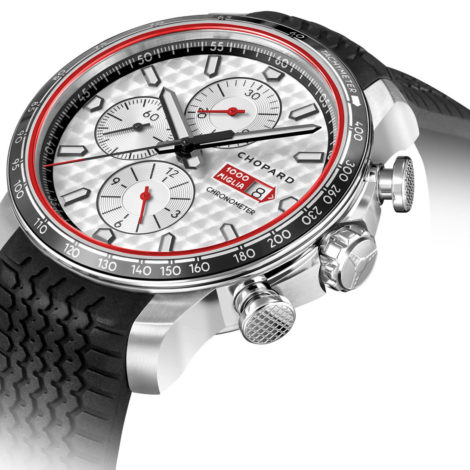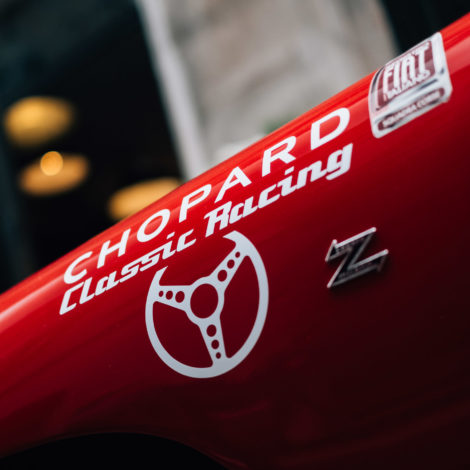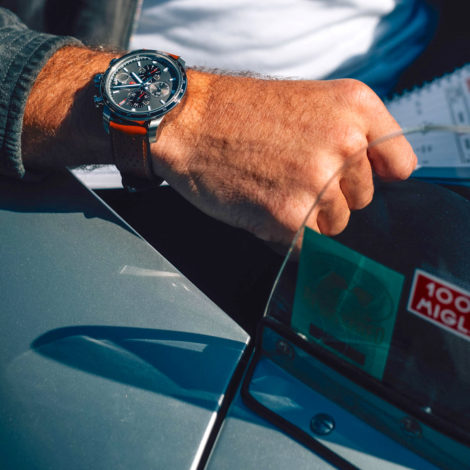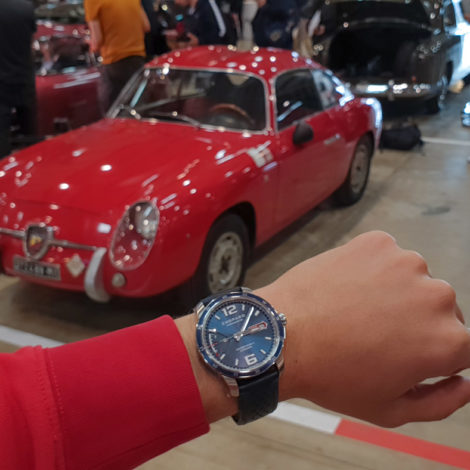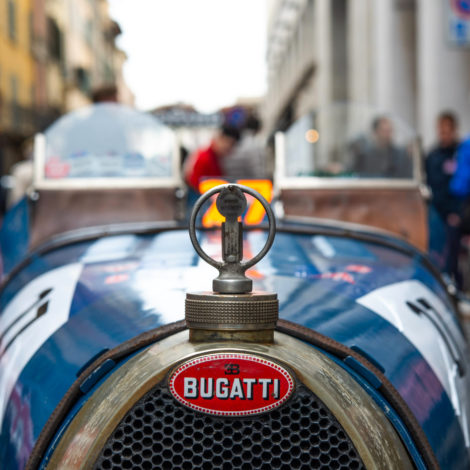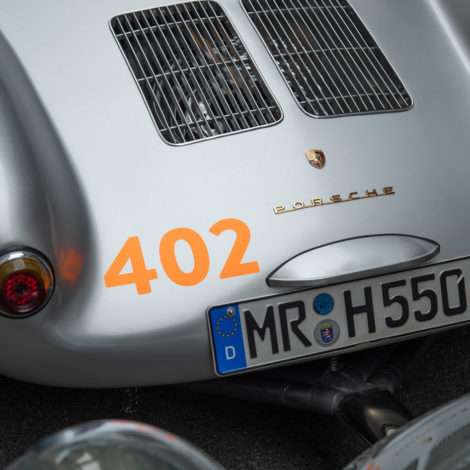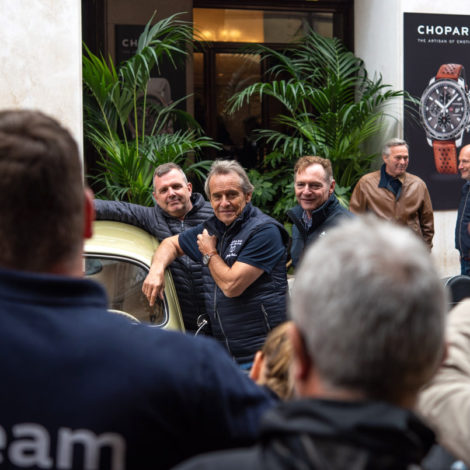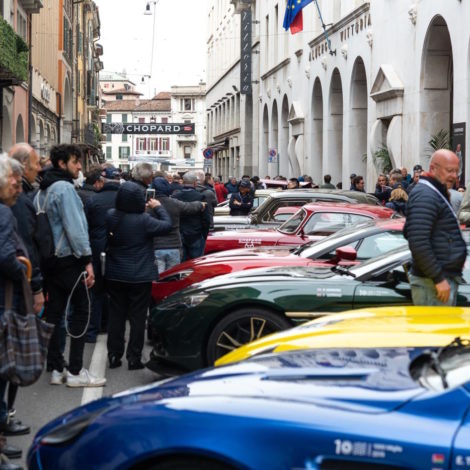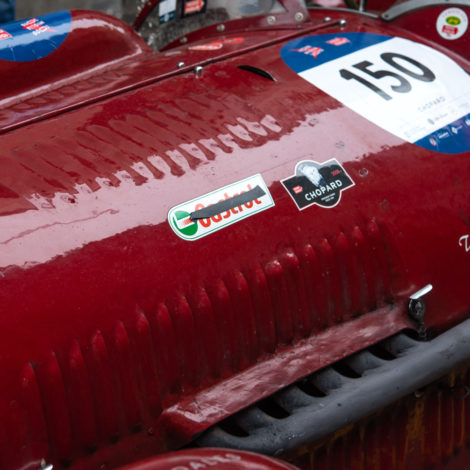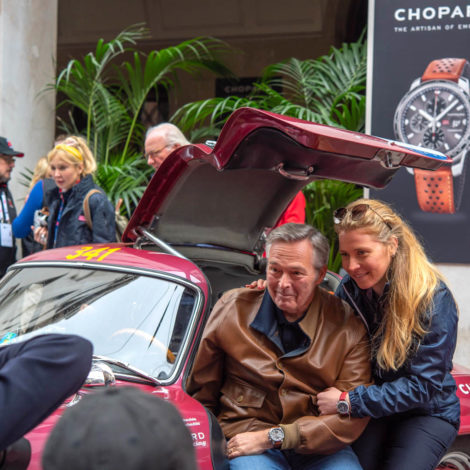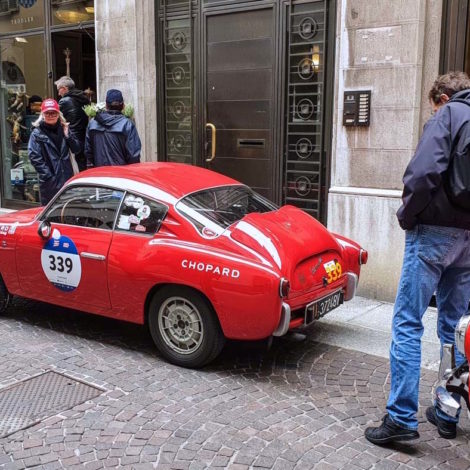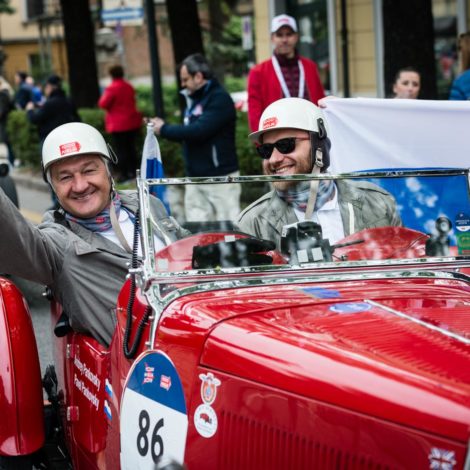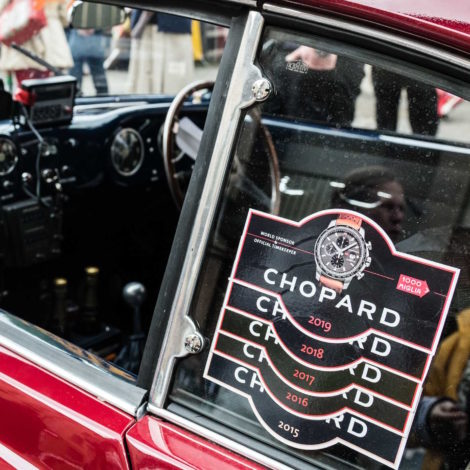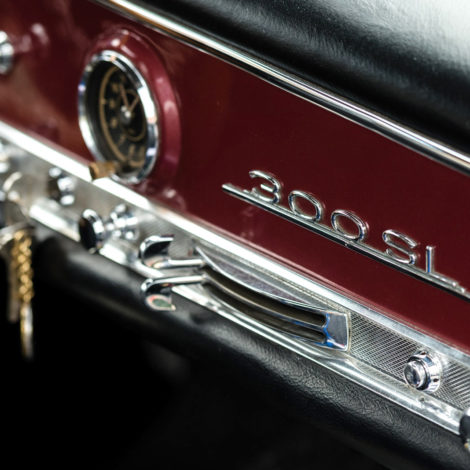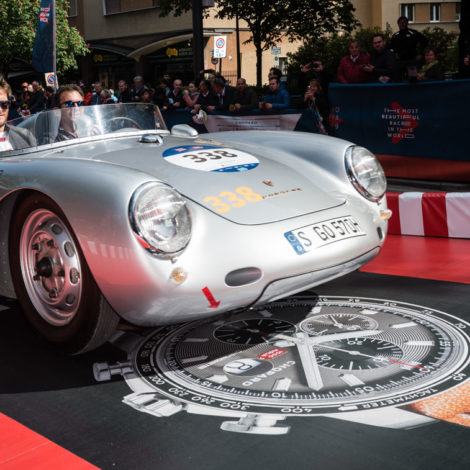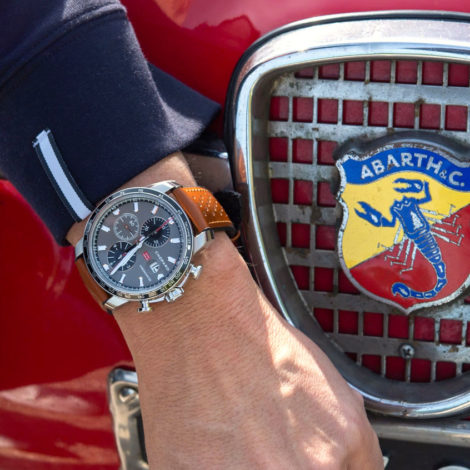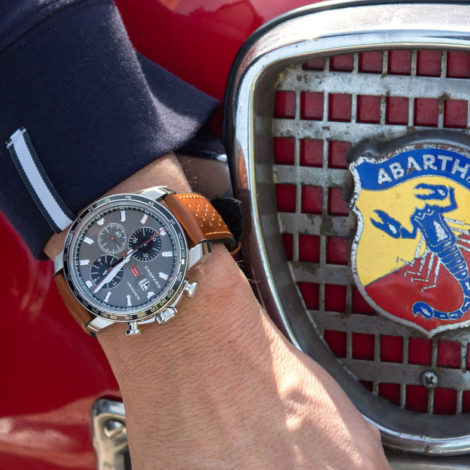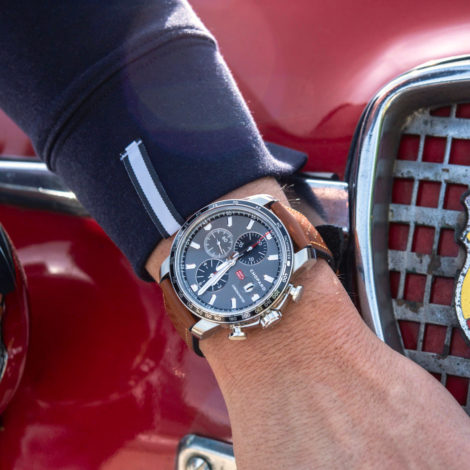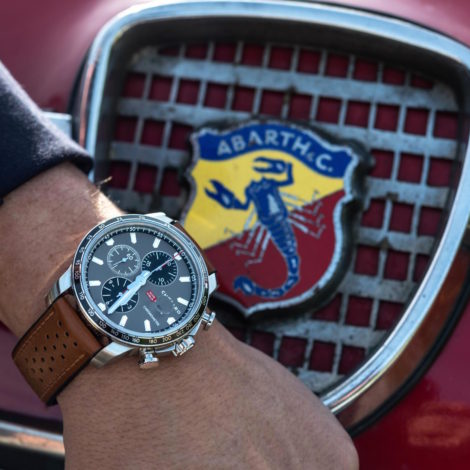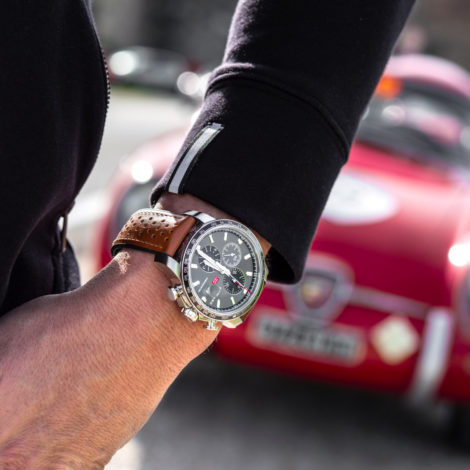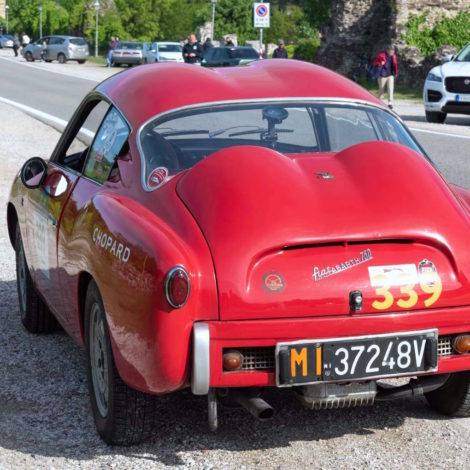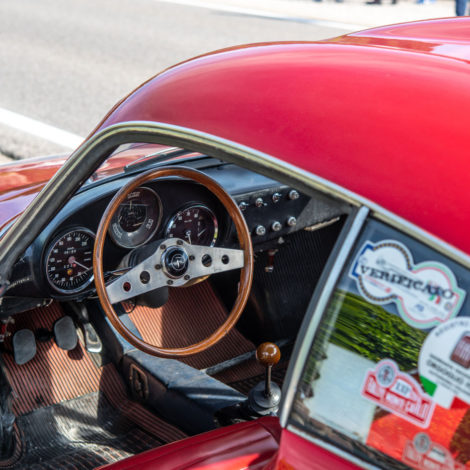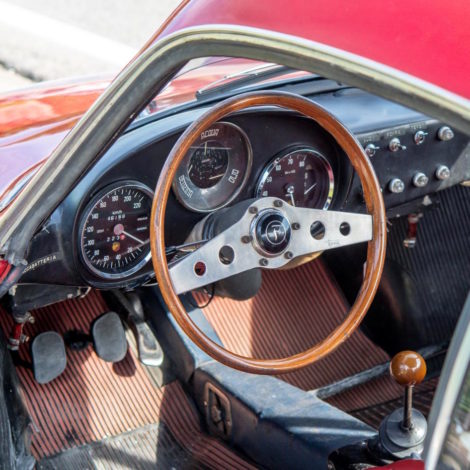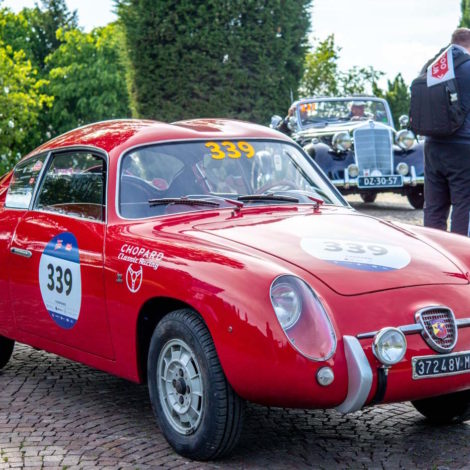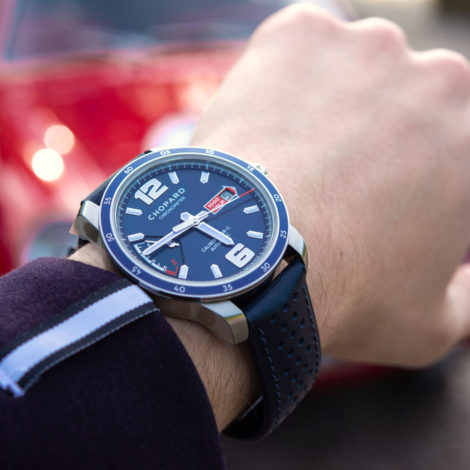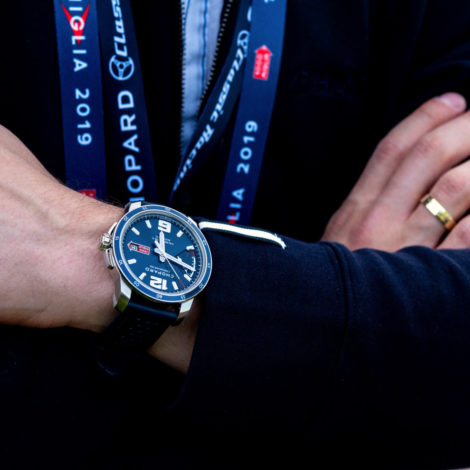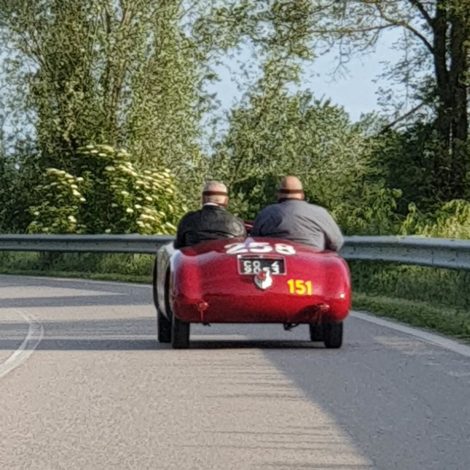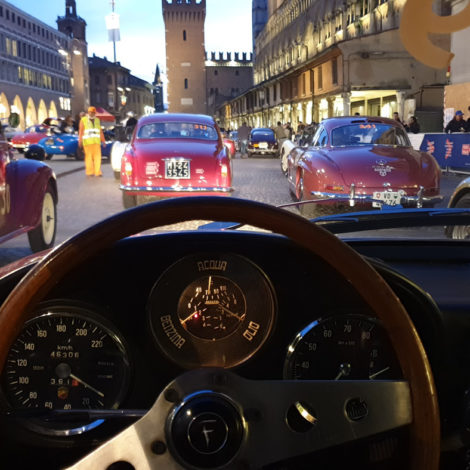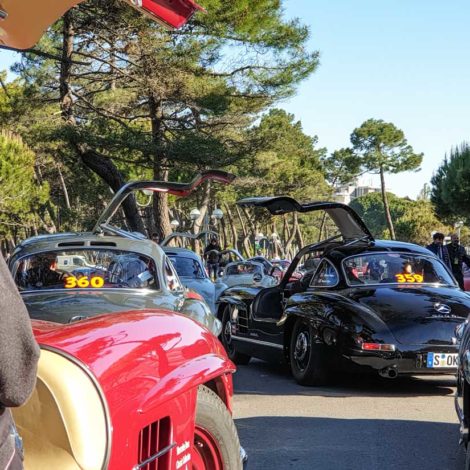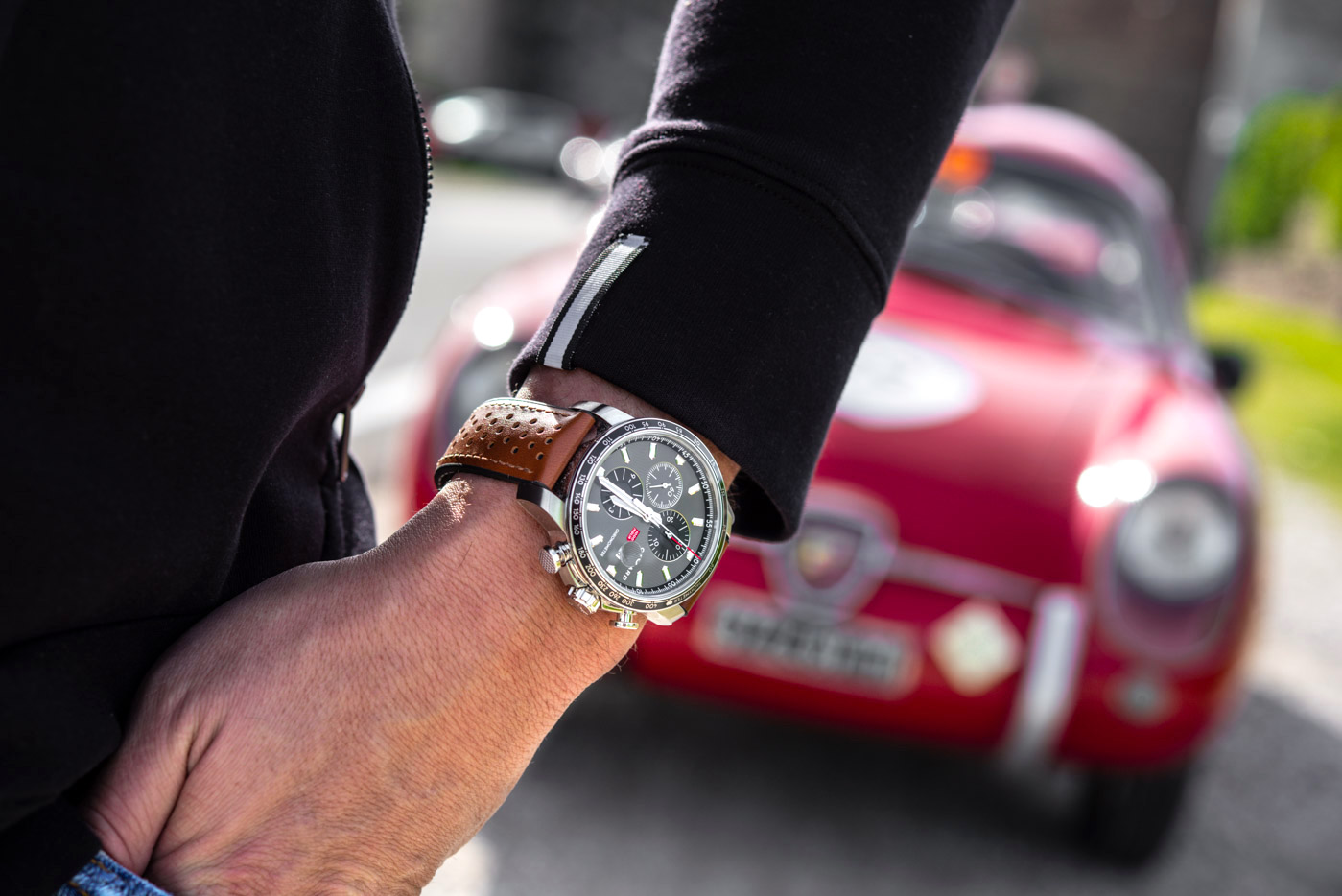
A few weeks ago I had the privilege and good fortune to participate in the first two of the four days of Mille Miglia 2019, the thousand mile race. And as I shall explain soon enough, it damn well is a race, around Italy, the beautiful! A thousand miles in vintage and ancient cars, not–so–expensive and stupid–expensive ones, driven from sunrise and into the night by people wearing period–correct clothing — and Chopard watches. Here’s the story of how I found myself in this car-lovers’ paradise and what I experienced over these crazy days, fueled by pasta, inefficiently burnt unleaded benzina, and a passion for speed as we once knew it.
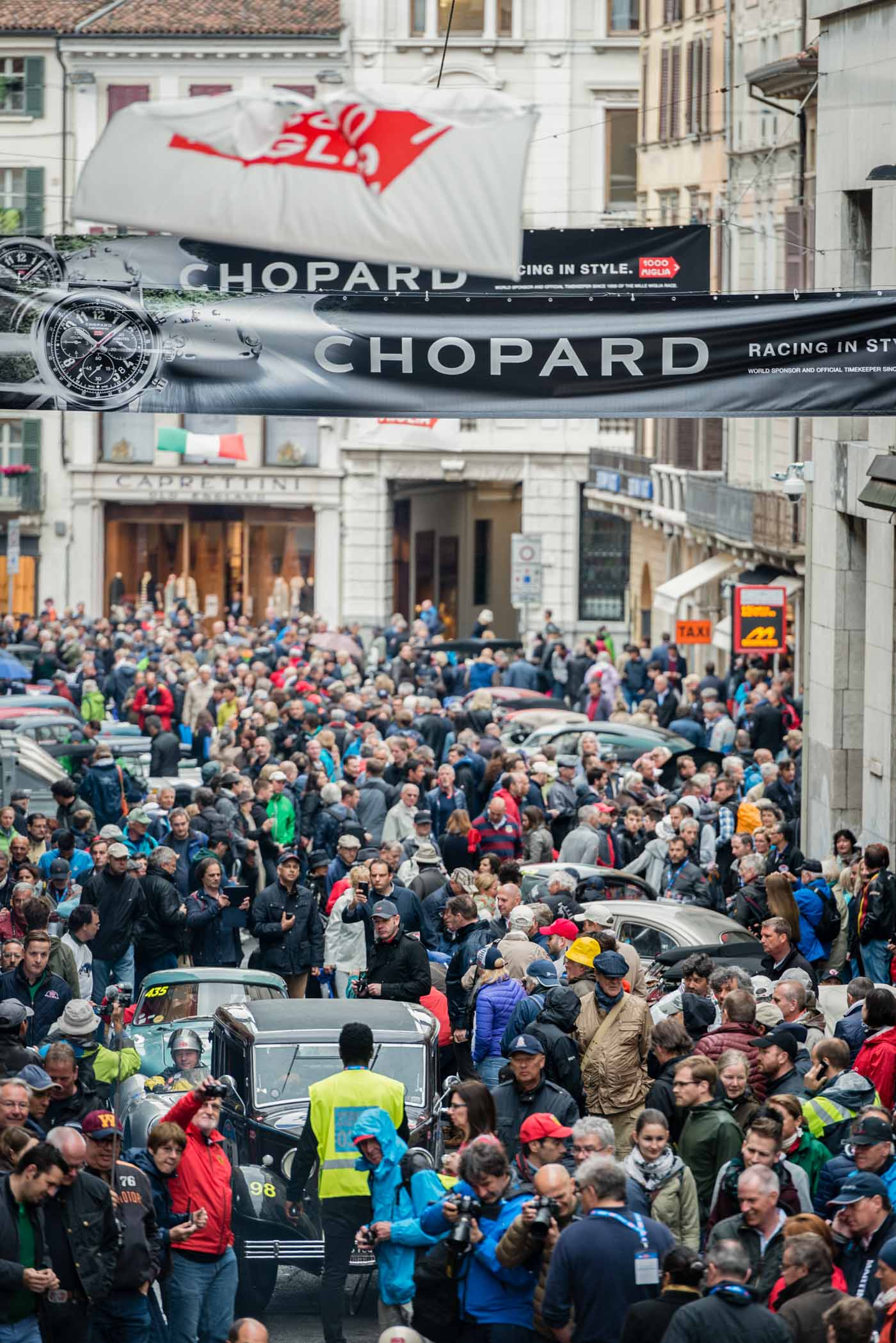
Every place, from Rome and Brescia to the smallest homestead, had crowds cheering for the cars as they blasted past them — and when all parked up, that’s when things really got out of control. This is just before the start, in Brescia.
Throughout my involvement with cars and all that entails, I have been intermittently seeing Chopard Mille Miglia watches on car-scene people’s wrists. For all these years, doing so made me wonder if it actually measured up as a car-lover’s watch, or if it was picked just because it was a decent watch that happened to have appealed to their owners. It was as recently as about half a year ago that it all ticked, when I saw the famously non–fashion–savvy Chris Harris review some car or another on YouTube, while wearing a Chopard Mille Miglia watch with the tire-tread pattern strap installed. It was then that I, late to the party as ever, figured it might just be the mutually accepted watch for car-lovers to say, “I do very much love my cars.” I mean, I pictured this well–heeled car reviewer looking at the watch scene, decidedly saying no to a Rolex Daytona (those who know Harris will have no hardship believing that he is not a Rolex guy) and all the rest of run–of–the–mill nice and expensive watches, until he stumbled upon the Mille Miglia,which so strongly radiates with a love for cars and for what, perhaps, is the most beautiful car race in the world.
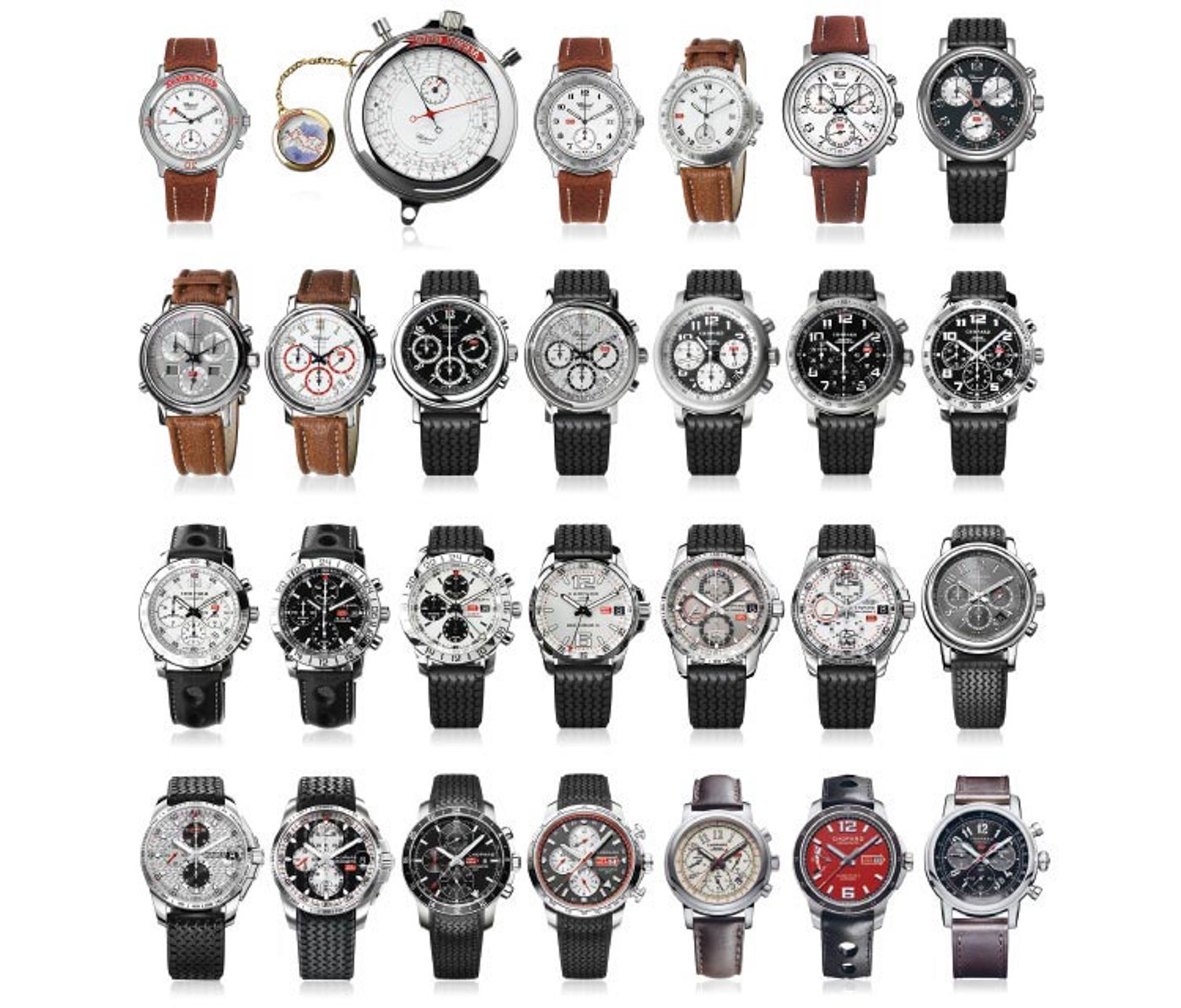
Chopard & Mille Miglia: 30 Years, 30,000 Miles & Some Two Dozen Watches Into It
It took Chopard 30 years of uninterrupted dedication to, and official partnership with, the Mille Miglia to turn this shy collaboration of 1988 into an established watch collection that, as we’ll see soon, can be the common horological tongue among car lovers. Although some sources quote 1998 as the inaugural year, when Chopard introduced a rubber strap with that cool and, for every car enthusiast, imminently recognizable vintage Dunlop tire pattern, this actually first happened as early as 1994. So, for 25 years now, and counting, that’s been an essential element of Mille Miglia watches and one that has helped car lovers gravitate toward the collection.

The Mille Miglia GTS Chrono Race Edition 2017 had a vintage dashboard–inspired perlage dial and the vintage Dunlop tire pattern on the outside of its strap — more recent iterations offer leather straps with this acting as the rubber lining on the inside.
I’ll plead to an early ignorance of all this. However, strangely enough, I distinctly remember the first Mille Miglia watch I saw here in Hungary, on a car guy in a garage, about 10 years ago. I was just getting into watches, but I already knew Chopard and that watch, so I recognized it right away. I strongly believe most everyone who currently owns and wears a Mille Miglia watch had a very similar introduction to it: seeing it on a fellow car enthusiast. Just about any other watch would not spark an interest in the otherwise shockingly watch–ignorant car guys — car people being hardcore watch people is a myth that watch brands want to believe but is, in practice, not at all true in the way that they see it. For car people to appreciate a watch, they need to be introduced to that watch. Then the magic happens — but hardly ever without. And so, there is something in the Mille Miglia watches’ dial design elements, as well as that strap, that make it such a perfect conversation piece — but only among car lovers. No one outside those circles will stop you and ask, “Hey, is that pattern on that black strap what I think it is? Off a vintage Dunlop tire?”
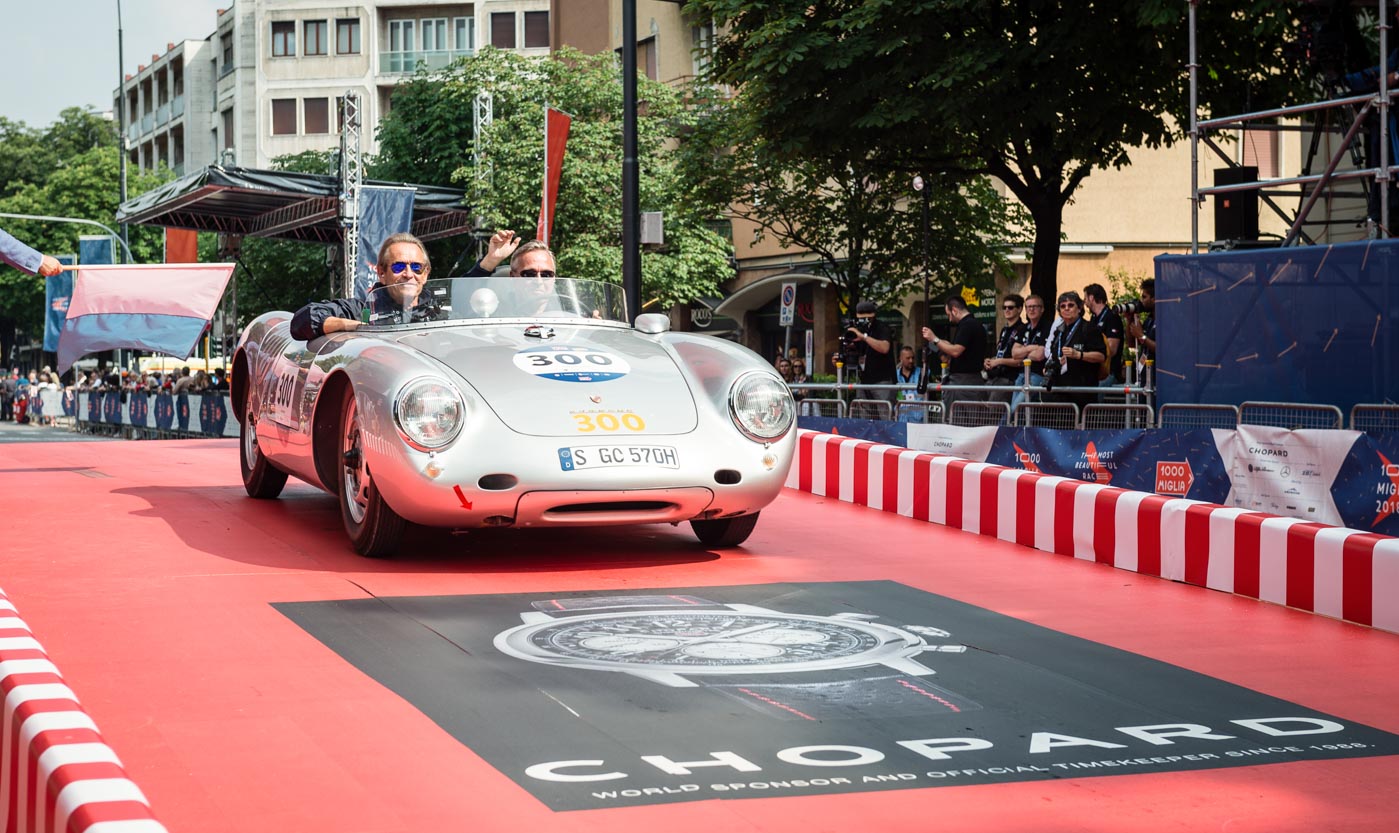
Enthusiasts of every field you can imagine want, need and appreciate these sorts of things that help them filter out the noise and connect them only with “those who already know or genuinely want to learn.”
I have seen brands plaster their names over every type of event you can possibly imagine, all in an effort to gain traction with said events’ participants. By contrast, as I learned through my research — including reading 1990 Motor Sport magazine scans that I found online — Chopard’s co-president Karl-Friedrich Scheufele joined the event back in 1988 as a fan of cars and the car scene. And Chopard’s involvement at the time was limited to handing out key rings (how cute is that?) to the participating teams. The established collection of car–inspired watches and the many massive Chopard signs along the route or the Chopard stickers on precious cars had not yet existed. Rather, Chopard and its collection of watches grew together with this partnership and with the Mille Miglia race itself — which now has 400-plus cars racing and other hundreds supporting the whole thing, turning it into an unmissable event everywhere it goes. I bet that growth is a path many current owners of Mille Miglia watches are not inherently familiar with — but all you need to do is go anywhere near the event to get a sense of Chopard’s deep–rooted and genuine connection with it. Take a look at the two images below, for example.
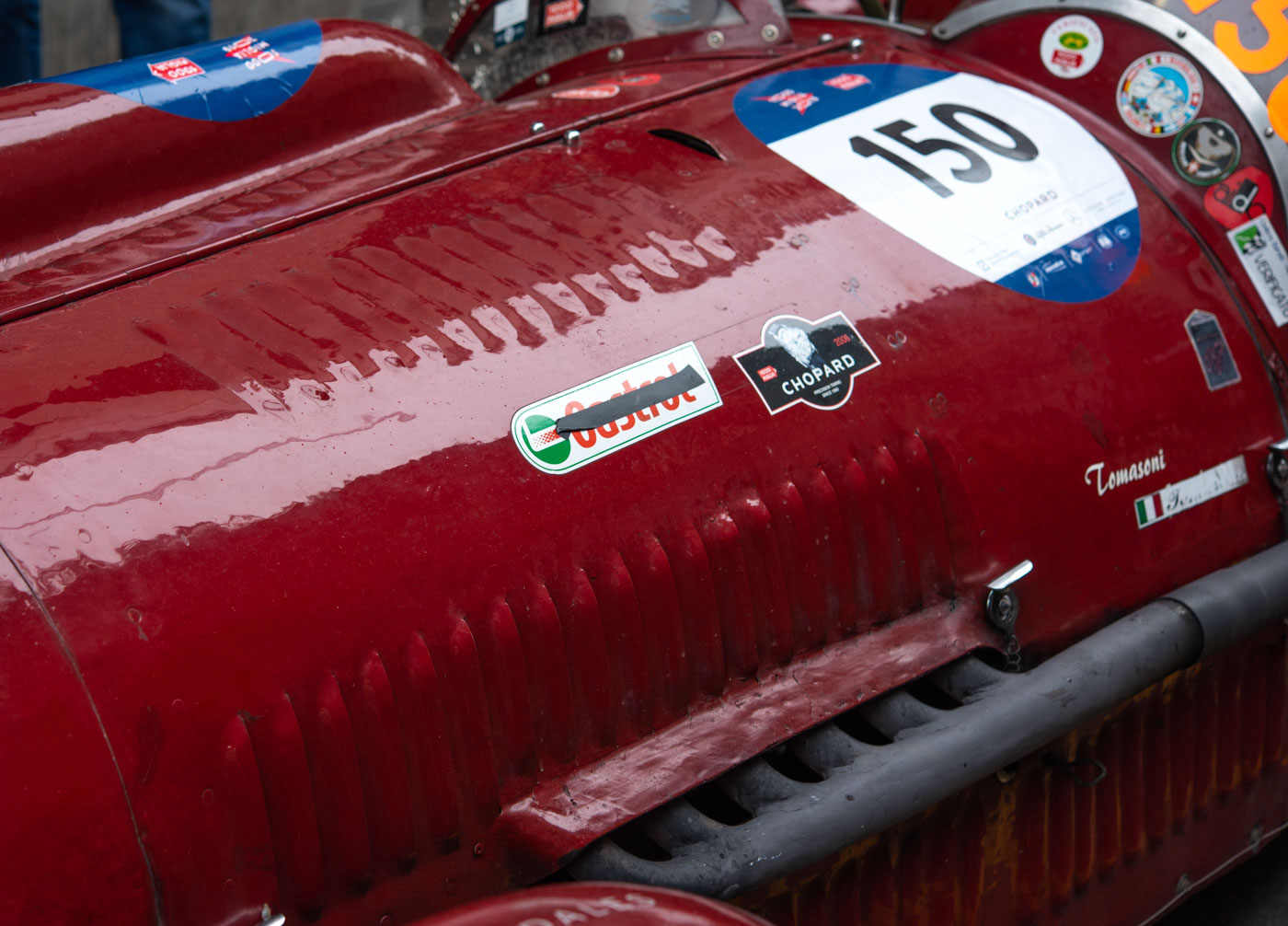
Surely enough, you’ll see Chopard prominently placed on the podium that all the hundreds of participating cars roll through at the end of each of the four days — but to me, at least, it was the stickers on the cars and the number of watches on people’s wrists that really stood out. Just take a look above: Castrol struck out, but a 2006 Chopard sticker still nursed on the obviously hand–hammered (and absolutely gorgeous) engine cover of this 1948 AMP Prete Alfa Maserati 2500. Just below: a bunch of specialized computers used to track the car’s progress throughout the different stages on the inside, and the fifth consecutive Chopard sticker on the outside, clearly marking the years in which the car has entered the race. As for the number of watches on people’s wrists, I’ll come back to that later.
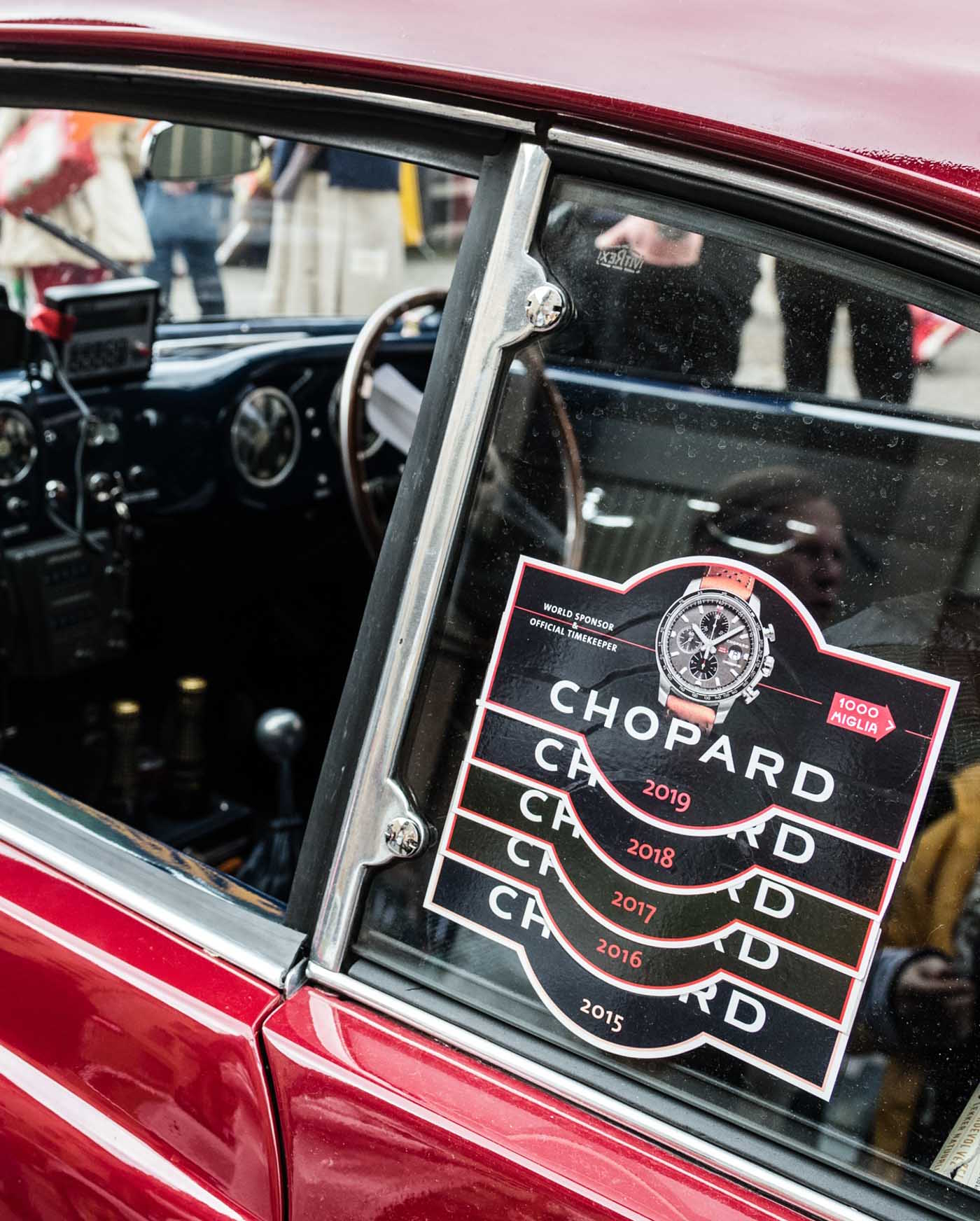
I explained a lot of the above to the open–minded people at Chopard and how I would love to, if there is a chance, visit the Mille Miglia, to see how flawed — or spot on — my logic was with respect to how car people choose, buy, and wear watches. I also felt like I, as a die-hard car lover (who’s been helplessly in love with cars since his first coherent thought) and watch enthusiast, have not yet seen or read a proper explanation of what makes the Mille Miglia watches so successful. I mean, it is a collection that’s been standing on its own two feet for 30 years now, but from the sidelines I couldn’t see how proper this connection with cars actually is — and I’ll go one stepfurther and say that, even when I arrived at the event, I still had no clue what to expect.
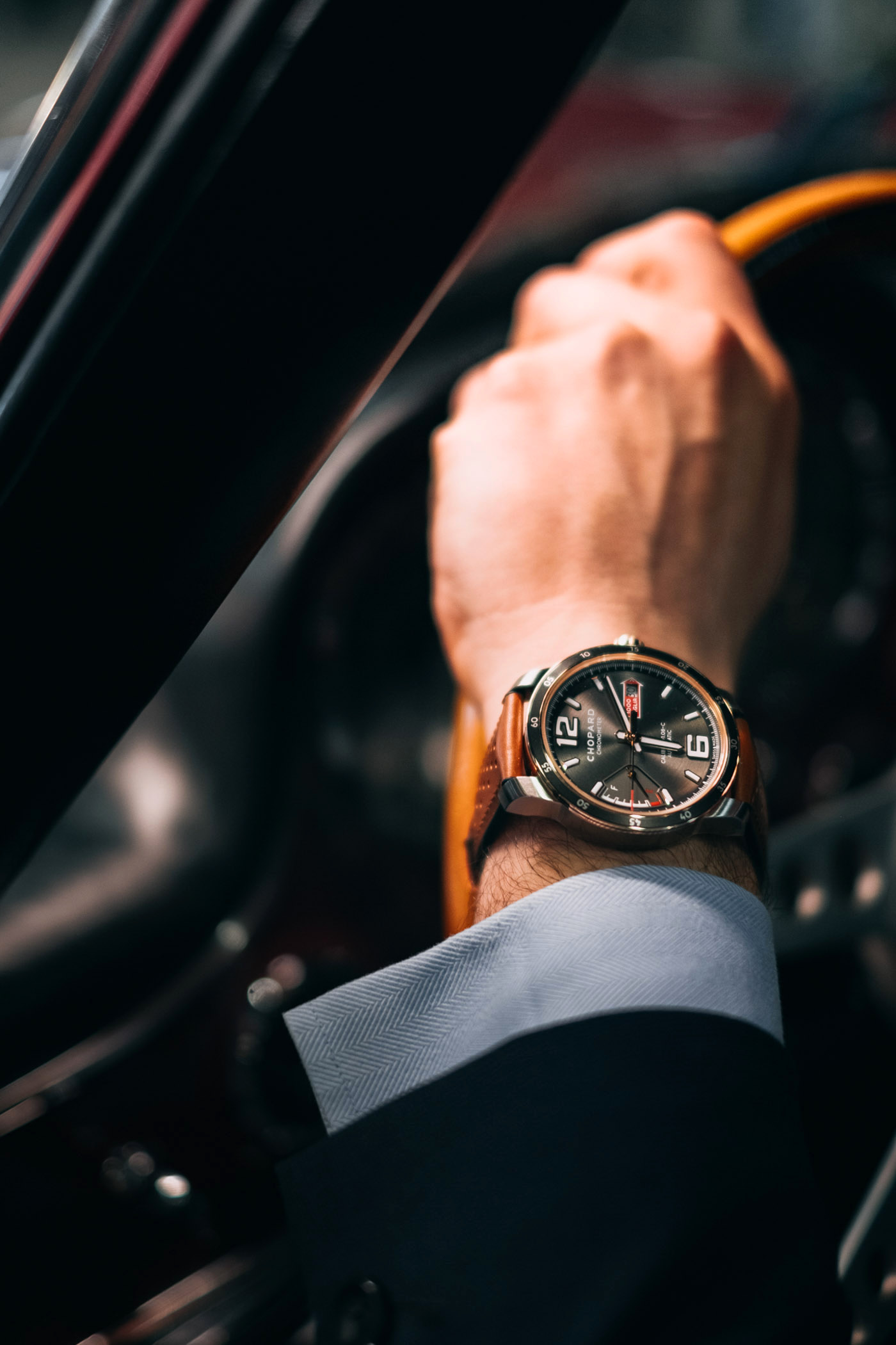
Finally, A Look Inside The Mysterious World Of Mille Miglia
If anything, I was borderline-bothered by the Mille Miglia collection. What was getting on my nerves is that I liked a lot of what Chopard had been doing and I liked every form of car racing: and here was a watch collection that should have appealed to me, and yet it didn’t, because I couldn’t decipher its design elements or its legitimacy to pose as the Mille Miglia watch. I was annoyed by the red arrow that said Mille Miglia, the Brescia text on the back — and I did damn well wish I could decide for good if this was a true car-lover’s watch that I should aspire to, or leave it well of my radar. And yet, it kept surfacing year after year, as Chopard kept on supporting the race — and so my interest, mixed with the mild frustration that curiosity can cause, endured.
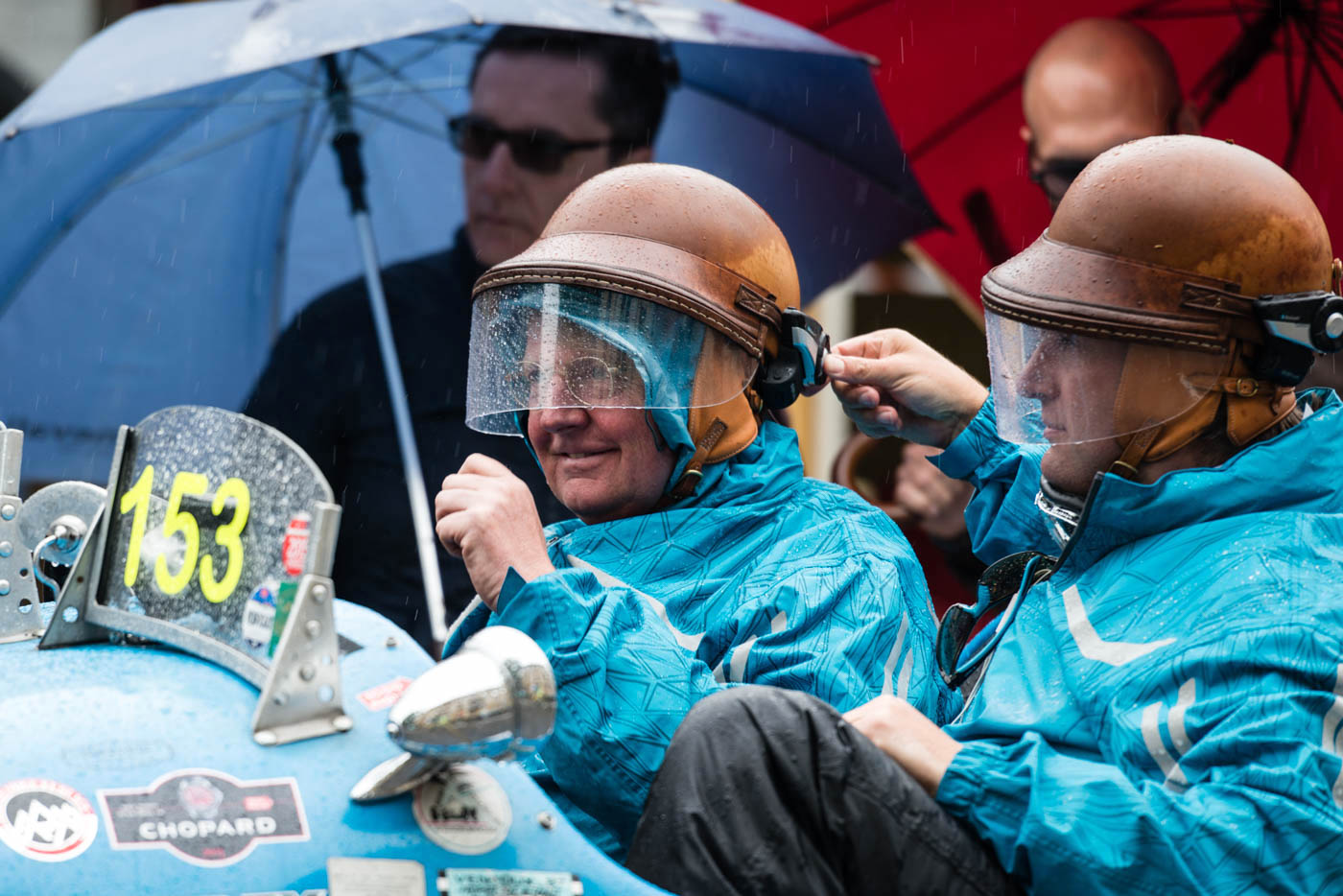
Long story short: Everyone — and I do mean absolutely everyone — who has driven on the Mille Miglia will want one of these watches. More to the point, most all of them apparently already own one or more of them, as I have been seeing these watches on just about every wrist at the event. As such, four things appear to be established components of Mille Miglia races: a) The cars, b) stickers, c) Mille Miglia watches of any vintage, and d) the four-day, sustained rush of adrenaline in everybody’s system.
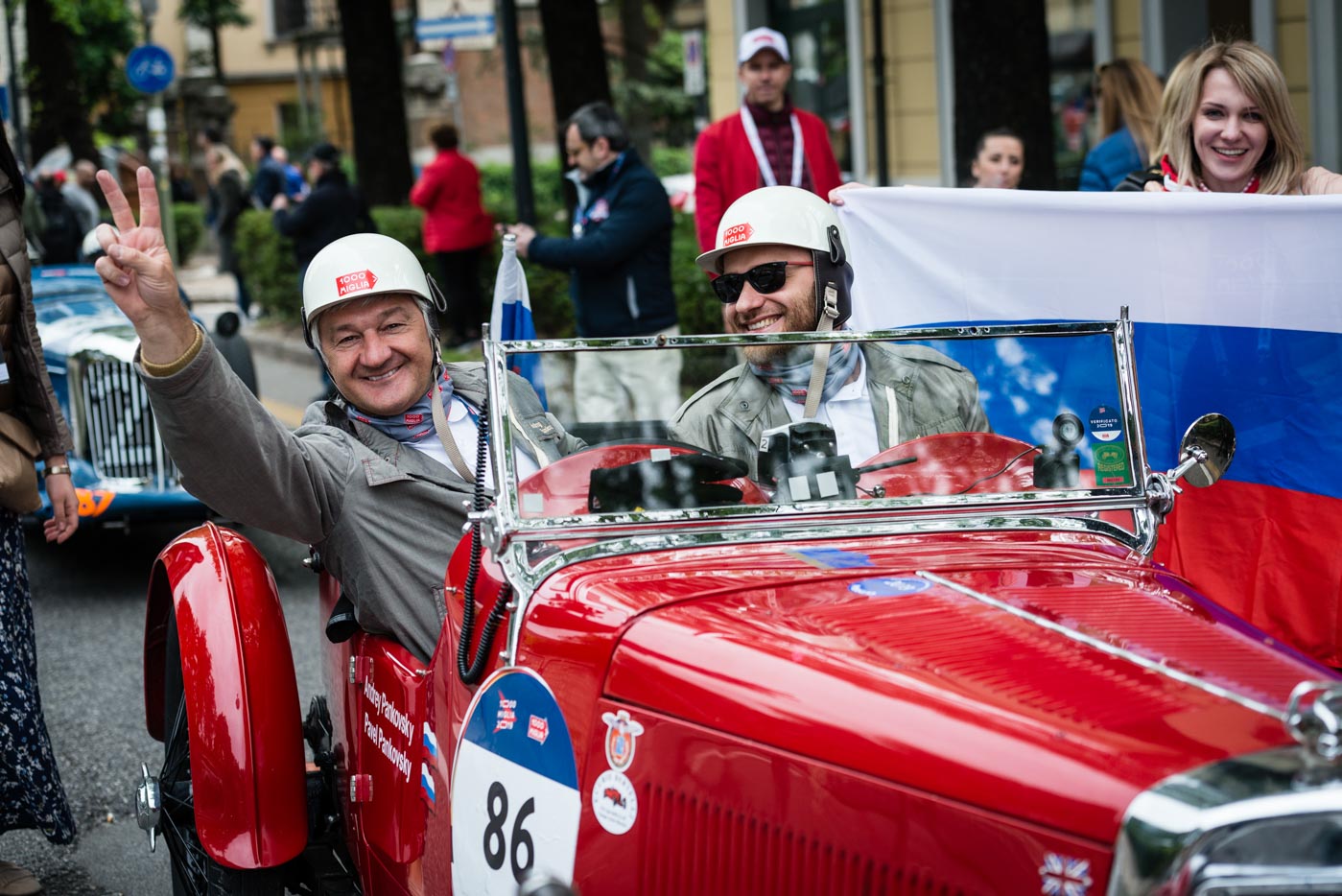
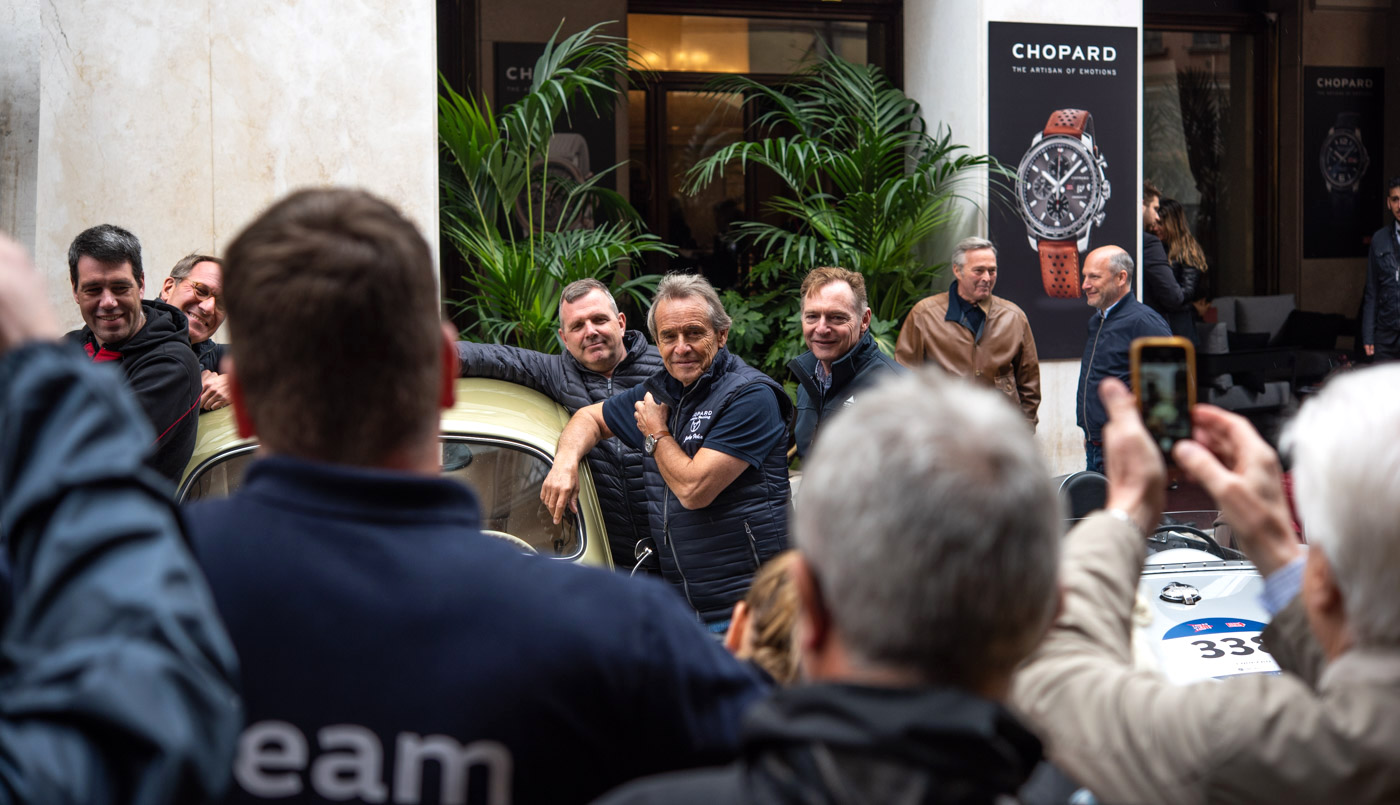
Jacky Ickx (in the center) posing for photographs before the start of the event. Chopard Co-President Mr. Karl-Friedrich Scheufele in the background.
On a side note, when Scheufele introduced six–time Le Mans winner Jacky Ickx at a dinner on the evening before the start, he said Ickx had been his co–driver since he first participated in the Mille Miglia 30 years ago, and that, “We used to drive a lot faster.” At this point, having not yet driven an inch on the Mille Miglia, a sense of disappointment rushed over me, having been led to believe that my concerns were not unsubstantiated and the Mille Miglia has been reduced to a rule-abiding cruise (ugh!) across Italy, full of much–too–precious cars and gentleman racers (i.e., elderly drivers) fantasizing over shiny carburetors and an early night’s sleep.
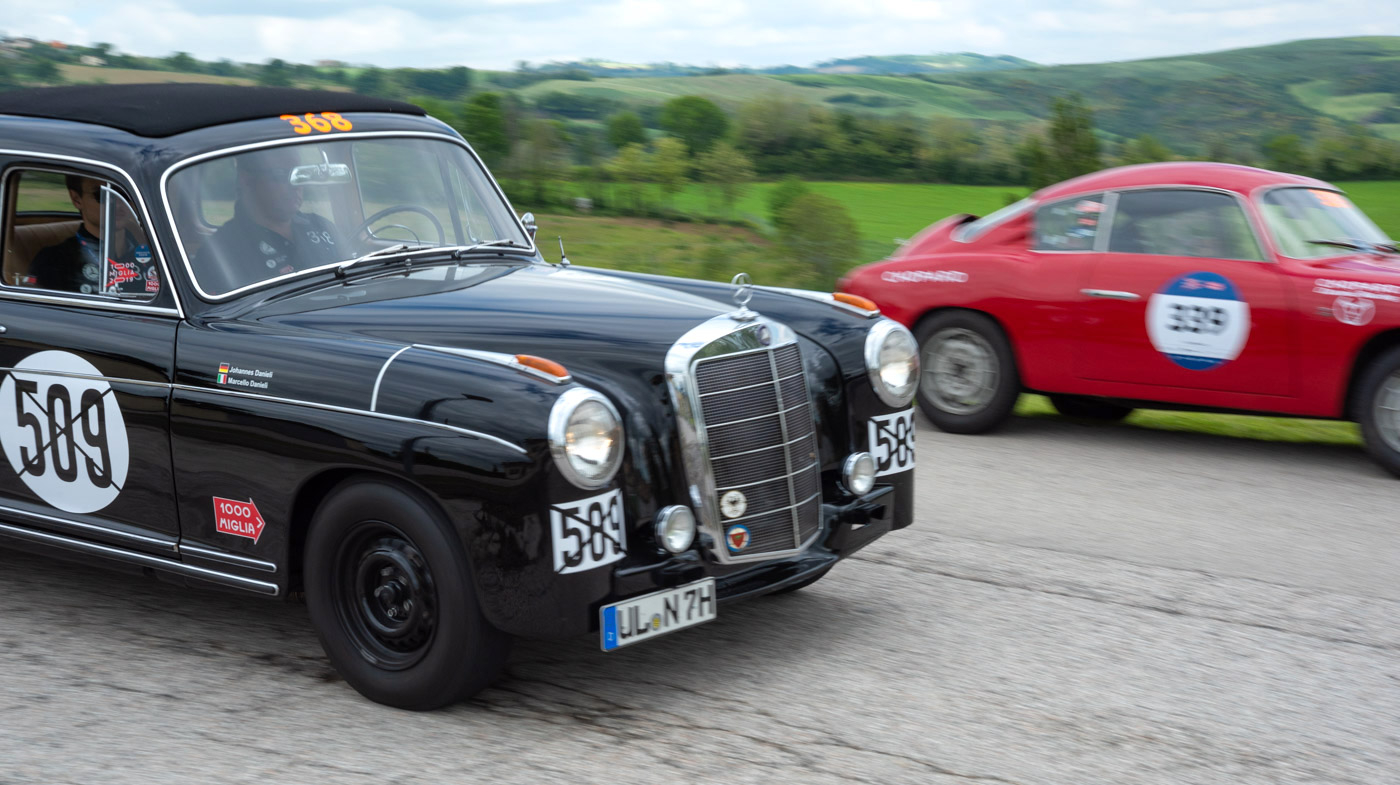
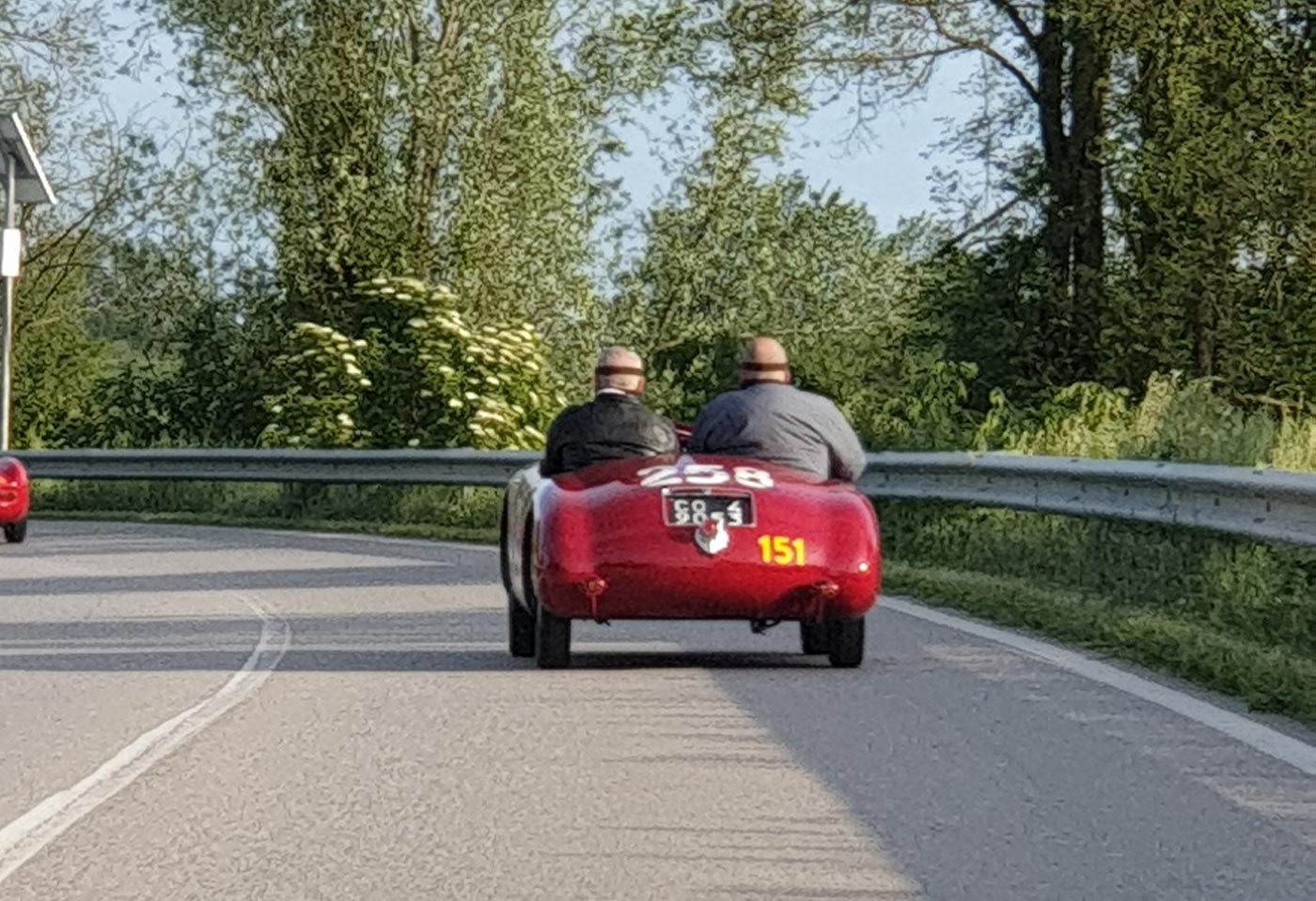
One of the more amusing sights on the road — the drivers might just weigh more than the car. (Photo snapped with a phone; apologies for the quality.)
Fortunately, speed is relative, and I was over the moon when I experienced from day one how this “rule-abiding cruise” was limited to respecting one rule, and one rule only: spreading the love of cars across Italy. And that, in Italy (unlike just about any other place in the civilized world, at this point) involves not only driving fast, but being encouraged to drive fast! Such joy! More on this later, as I shall now explain the start of the race, the point of these red arrows, and how gentleman owners of million–dollar Mercedes Gullwings end up driving their 300SL’s like total lunatics.
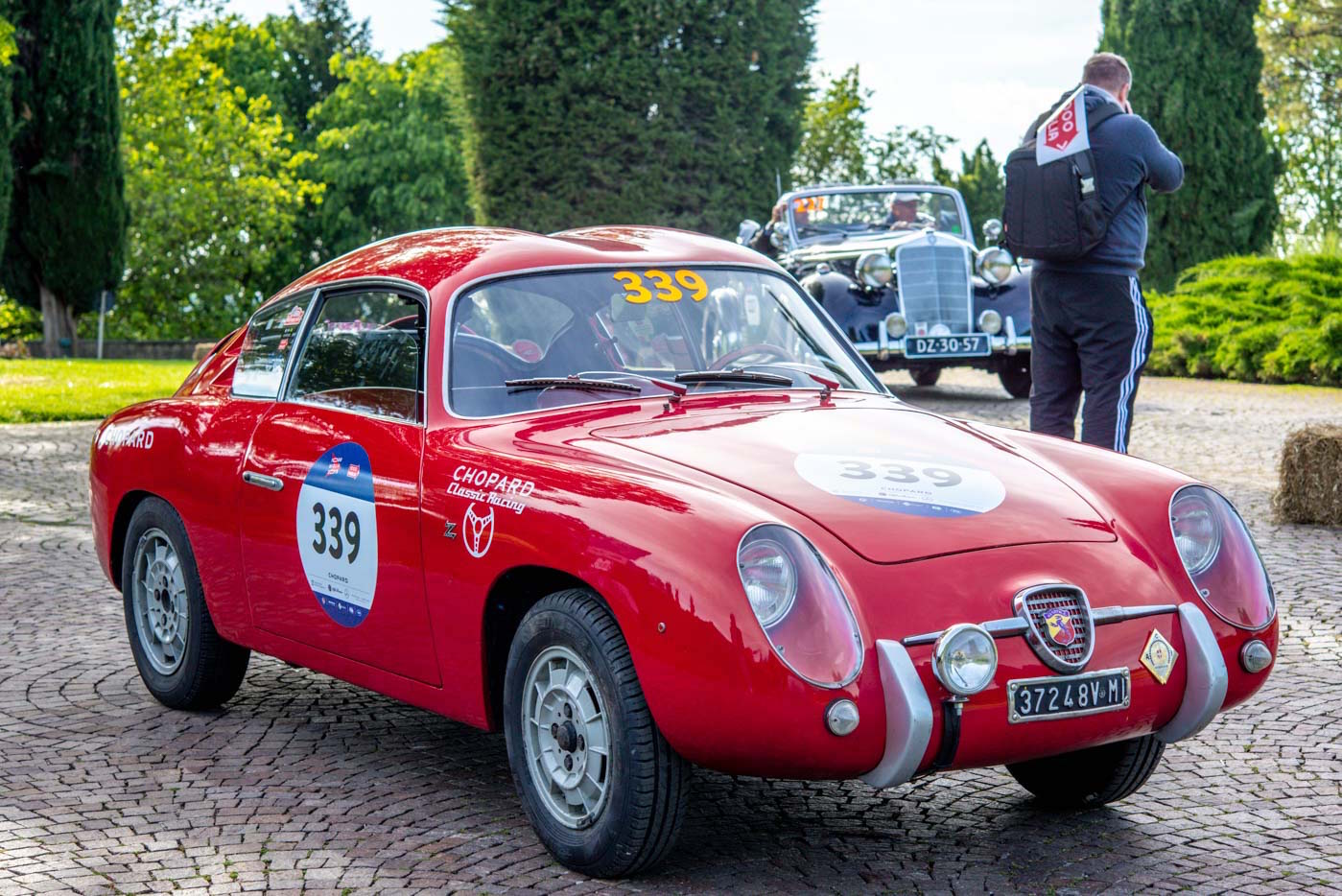
Driving The Abarth 750 Zagato Double–Bubble
Our car, generously provided by Chopard and by the single SI unit of Italian car lover, Pietro, was a box on wheels. But such a pretty and fast box it’s been! It is an Abarth 750 with a Zagato double-bubble (I should say double-trouble) body over it. Two low–fitted seats, a small parcel shelf behind and no safety equipment whatsoever make up the creature comforts of this bubbly rascal. As such, in my experience, the words “Abarth 750 Zagato” roughly translate from Italian into “Absolute Deathtrap 750.” With four wheels, each a genuinely unnerving 145mm-wide and with unassisted drum brakes in all four corners, the little Abarth made not only driving but also successfully and safely stopping, into an occasion of overflowing relief and joy. Stamping the servo-less brake pedal while firmly grasping the wooden steering wheel is quite the experience — even though the first 10 or so minutes of driving would also involve simultaneously applying a bit of throttle throughout the entire process to prevent the engine from stalling.
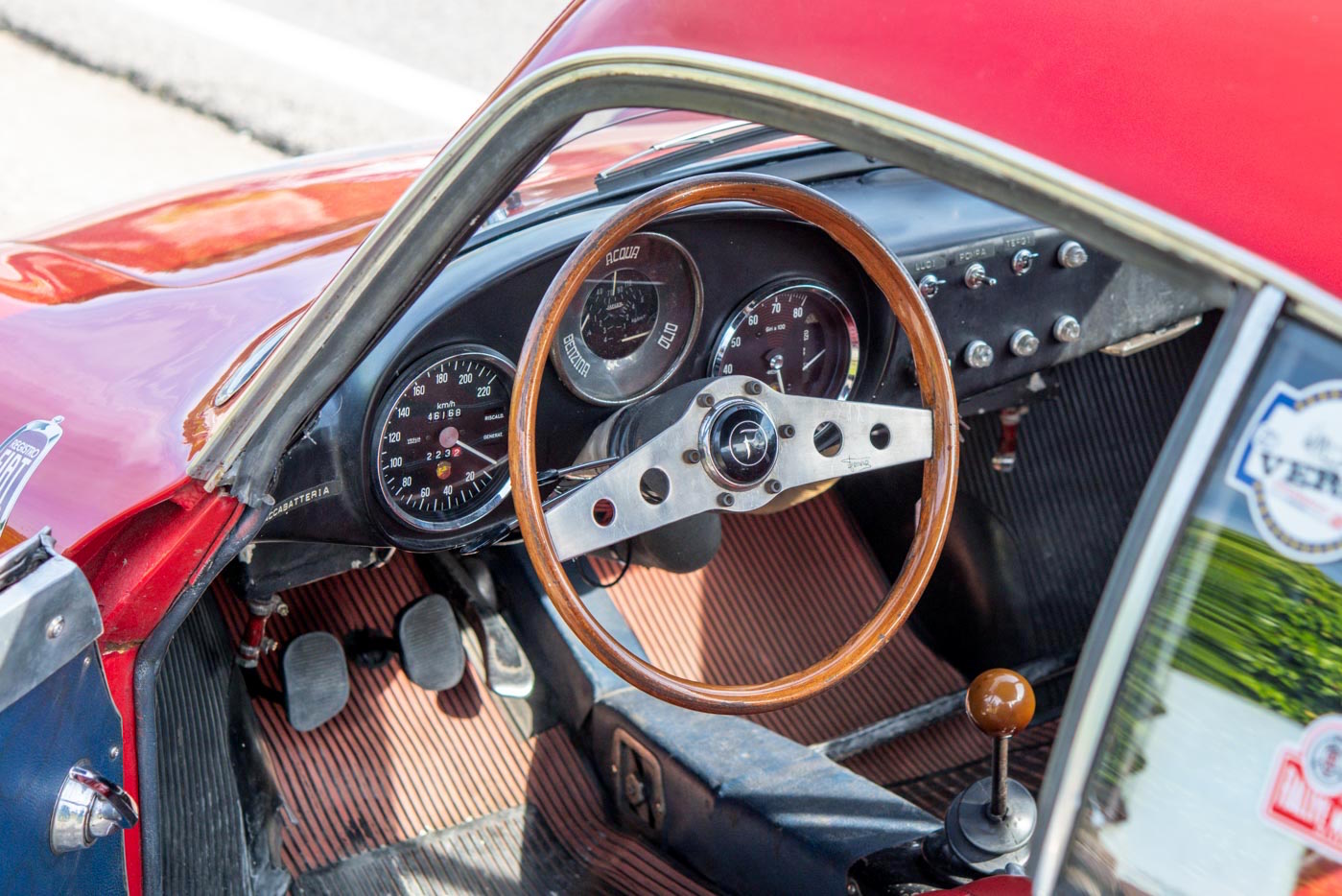
Our thrilling, unforgettable and super-exciting torture chamber for the first two days of Mille Miglia. Unassisted everything — and revs to an indicated 7,200!
So, picture yourself driving a car on 145–section tires at around 50 miles per hour (nothing crazy just yet), when you encounter a perfectly normal traffic situation, such as cars slowing down as one wants to make a turn. You apply your regular amount of pressure onto the unassisted brake pedal and not even the slightest alteration to your speed of travel takes effect. Pressing it yet more firmly applies the drum brakes and you begin to slow down, but not quite at the rate you’d wish to experience. Pressing it harder begins to reduce your speed, but then the car takes a massive dive to the right, so you need to violently steer in the opposite direction to stay on the road! Meanwhile, to add that extra bit of Italian flair and driving passion, the engine wants to stall. If you swap the cogs down, you should a) know your heel and toe and b) act fast, otherwise the cold engine will stall, should it spend a moment too long in neutral. Either way, sooner or later, you will need to apply a “bit of trottle,” as Pietro liked to call it. So there you are, massaging three pedals at once, holding onto a wonky steering wheel with a deadzone of about two inches in either direction, desperately searching for the next gear in the little gearbox (which, to its credit, is probably the most compliant interface in the entire car) while steering in the opposite direction that the car was diving for as you were approaching stationary cars at a rate of 50mph.
Absolute madness!
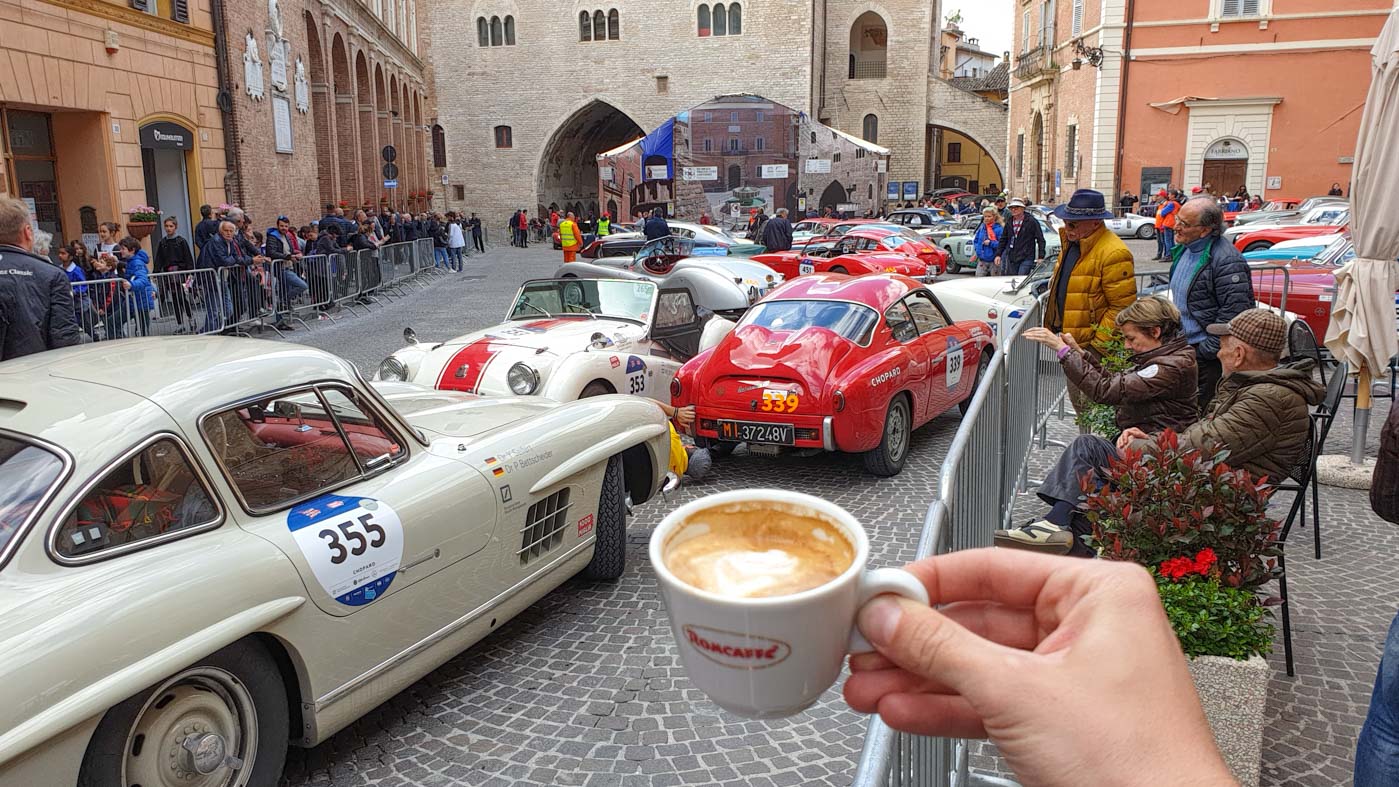
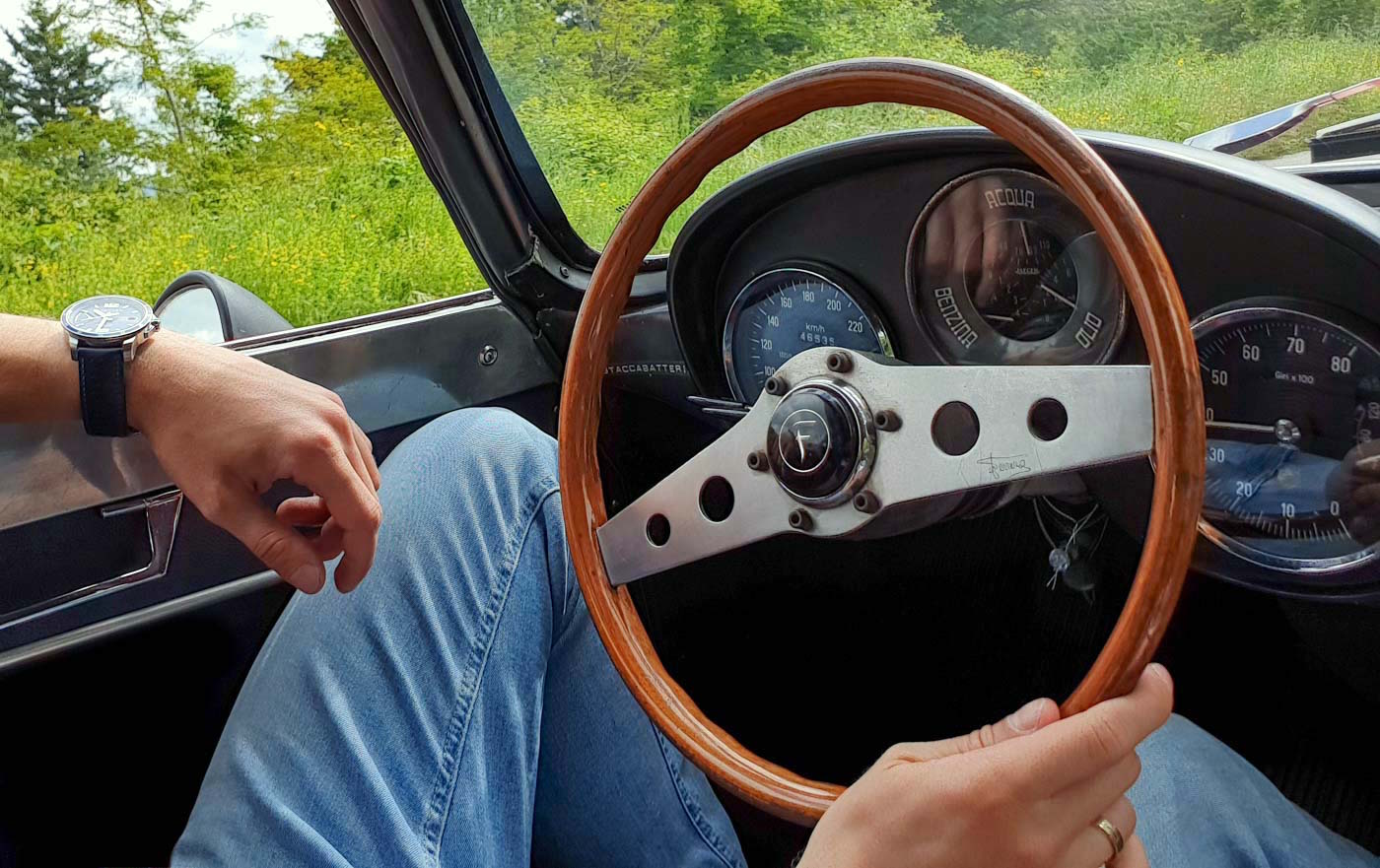
Driving the little Abarth is the thrill of a lifetime, not because it’s fast by modern standards, but because you feel more on the edge (of death, in all seriousness) than you would in a cozy, modern-luxury sports car. And if you do enjoy the act of driving, and driving well, you will soon enough get to grips with it. The suitably wonky Jaeger dials do, after a while, start reading and give you a rough indication of what you already know: the car’s warmed up. As these two things happen — you “mastering” the drive and the car heating up — a wild Porsche 356 or a silver 300SL Gullwing shows up and the chase begins. This is a good time to look at that speedo (to the left in the triple-gauge cluster shown above), calibrated to a highly optimistic 220kph (120mph), even though the car’s top speed was officially quoted at 156kph (or about 98mph).

More Gullwings than one could shake a stick at! We were a bit late to the start of Day 2 and were expected to navigate in between these menacing-looking, multi-million-dollar machines.
Meanwhile, everywhere we went, the energy was such that it put F1 races to shame. From the most remote homestead to the busiest city center, people from age five to 105 were standing and sitting and running, waving, cheering, and photographing along the road. Not one single disapproving look or any such encounter — and I must say, the race does turn the lives of these tranquil little Italian cities upside down. Working days or school time, rain or shine: nothing was an issue. Well, maybe apart from that nice old lady who quite literally leapt through my lowered driver-side window to shake our hand, while shouting “Abarth!” and some unintelligible, but highly enthused Italian phrases at us. The love of cars and driving has, indeed, united people.
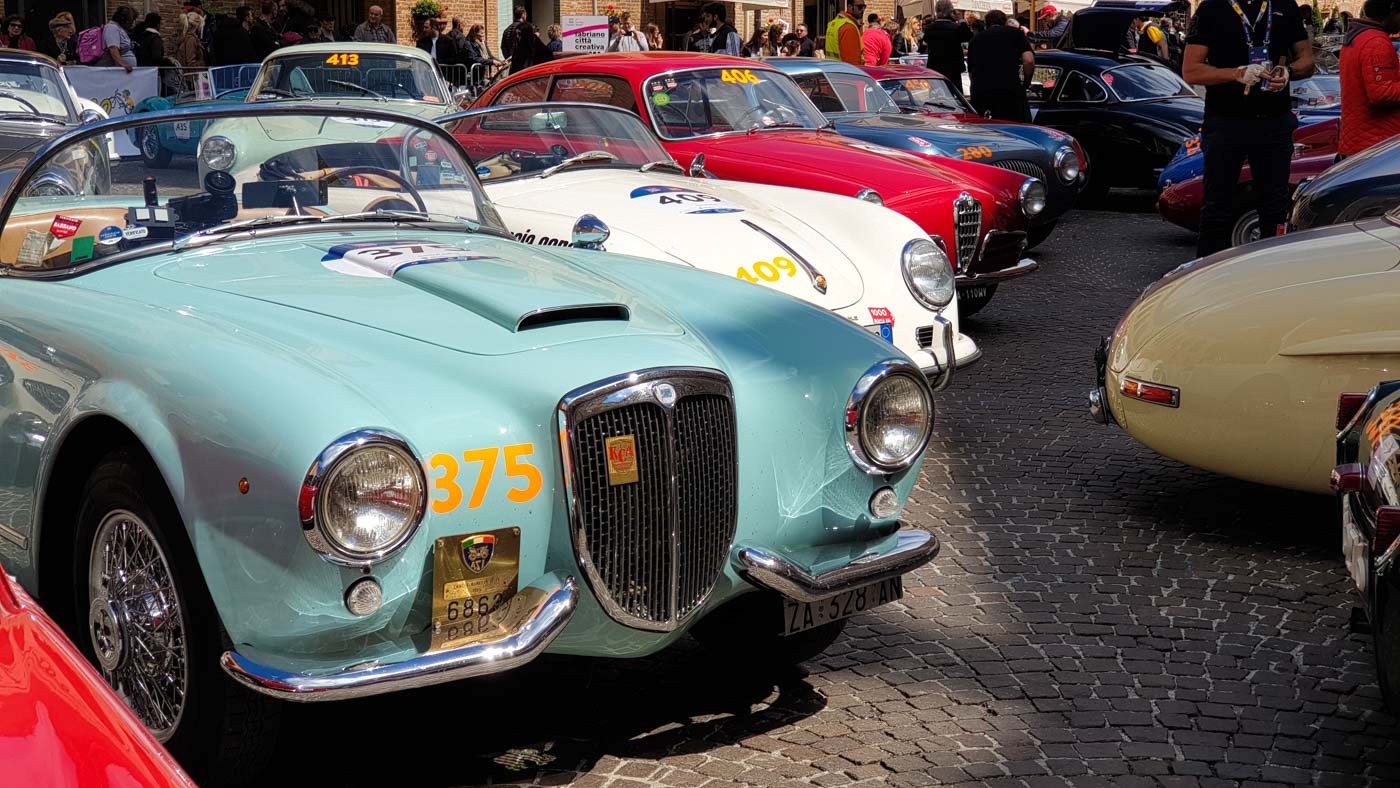
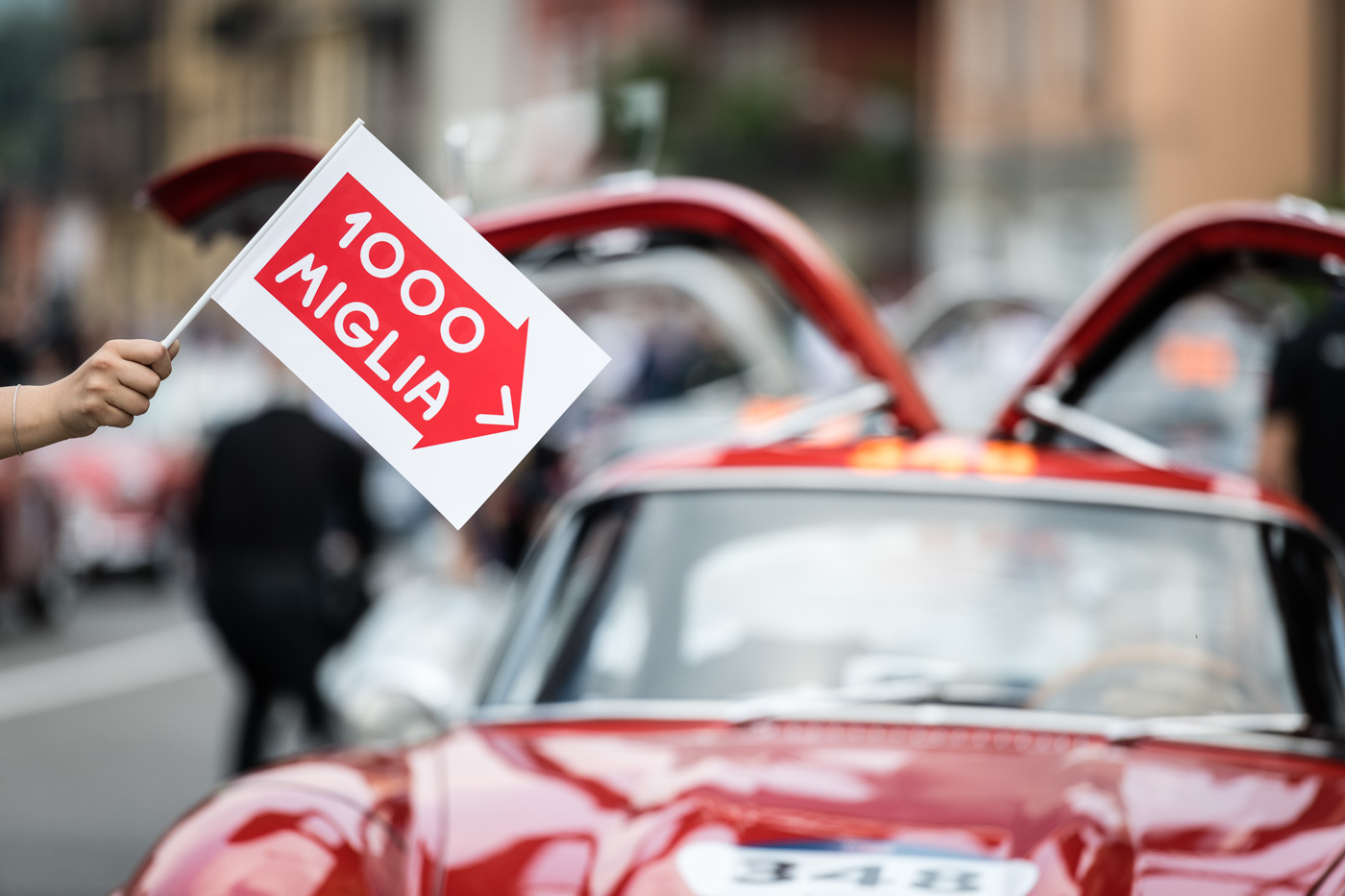
Every car is assigned a very nice travel bag in a blue linen-like material, filled with little gifts from the sponsors of the event, as well as four very hefty road books, complete with guidance for the 1,000–mile journey that lay ahead — a lot like the stuff rally co-drivers use to navigate their drivers down the stages. For complete noobs like myself and my co-driver, every major turn (well, almost every one of them) throughout the entire route is plastered with red Mille Miglia arrows that show the way. Going into a roundabout you have one, and you have one for every exit that you must or must not take, so that you find the right one.
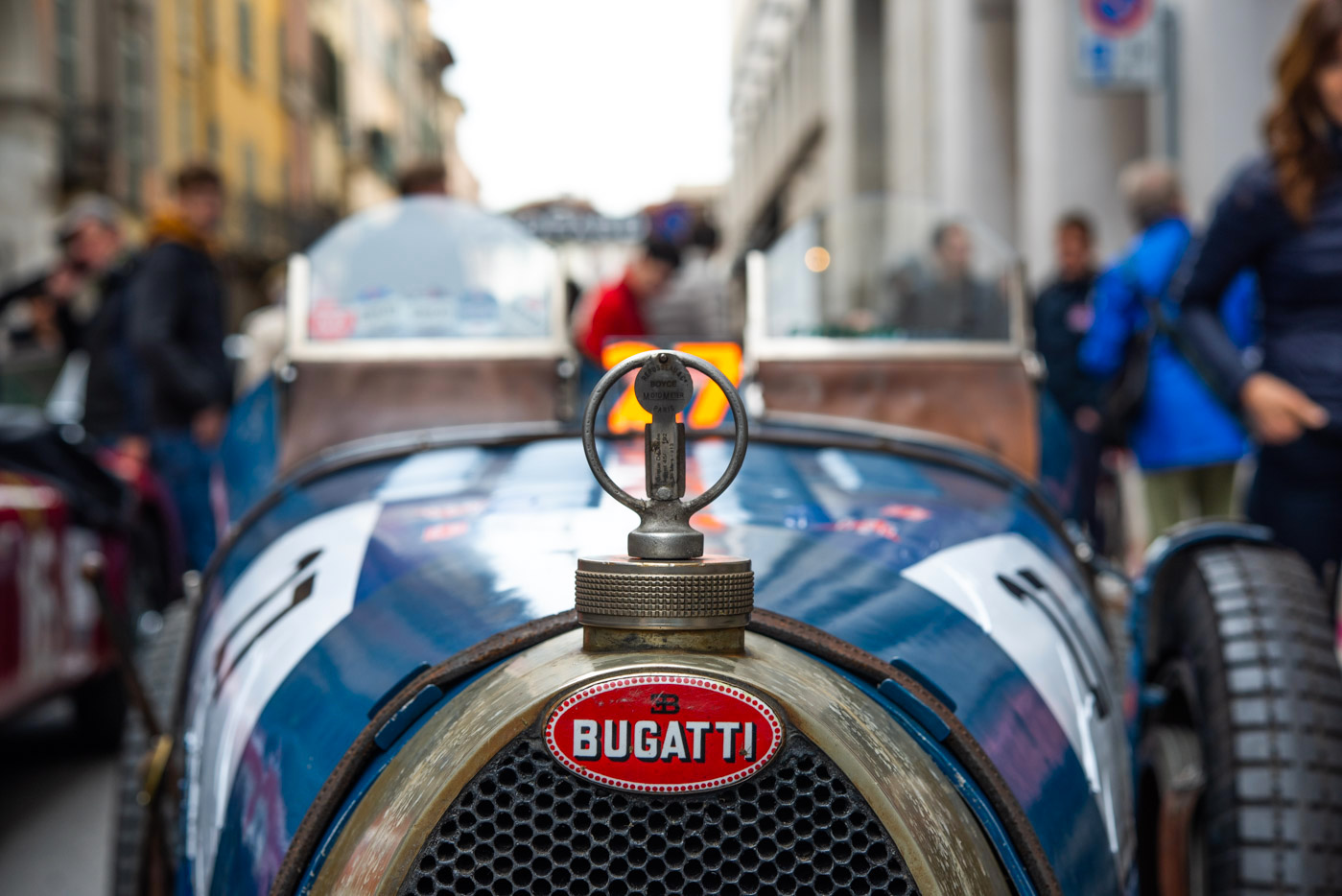
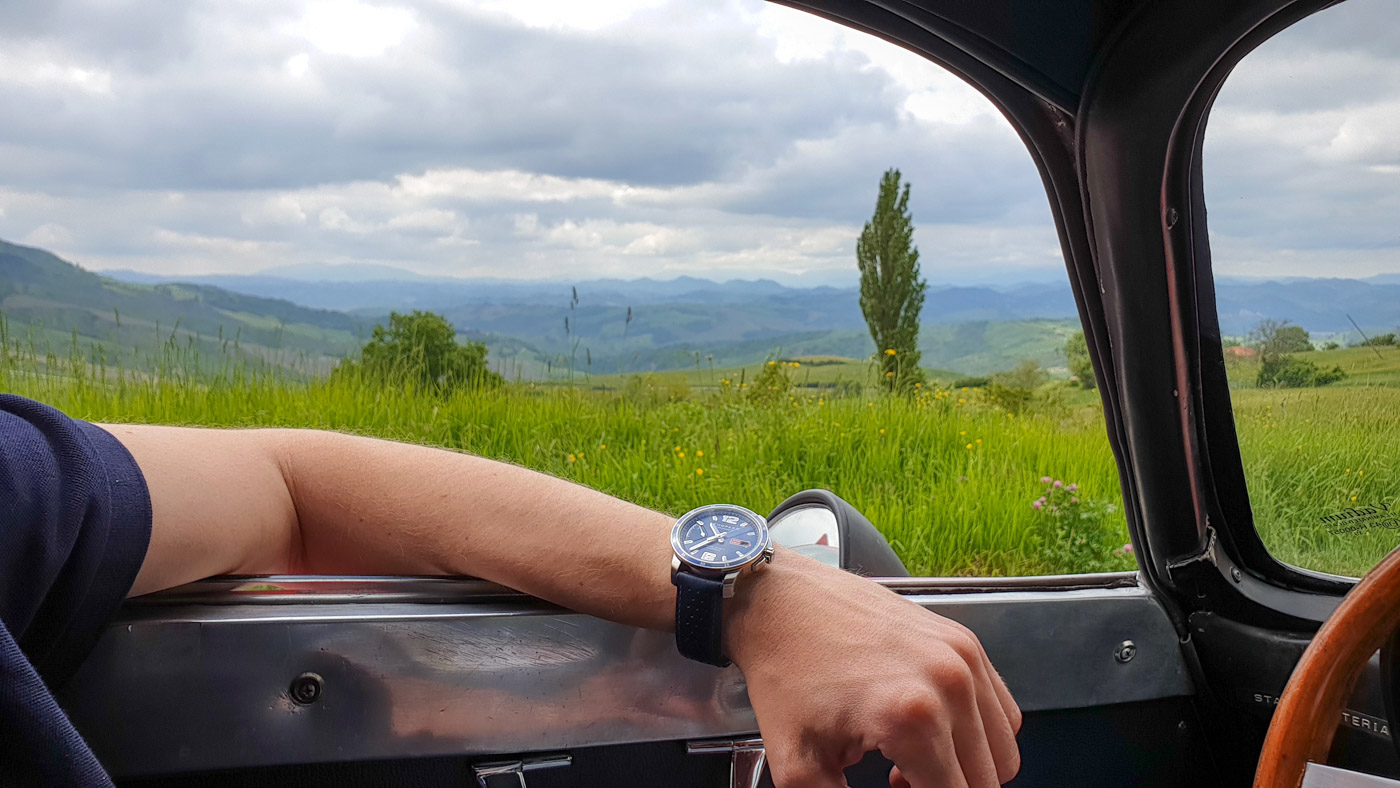
Soon enough, these red arrows become the be-all and end-all of one’s vision, reaching higher priority than any other traffic sign, police car parked on the side of the road, or other worries that one gets overwhelmed with in day-to-day driving. These little red arrows are pointing in the direction of yet more driving glory — and so everyone is more than eager to follow them. These arrows are prominently placed on the dial — and sometimes also the caseback — of Chopard Mille Miglia watches, serving as an apt reminder of the fun, the challenges, the highs and the lows of one navigating down a thousand miles, irrespective of road and traffic conditions, wrestling with cars that very much have a mind and a mood of their own. Having a Mille Miglia watch dressed in these little details associated exclusively with this experience, and nothing else, is like having a token of memory that one can see anytime one wants, counting down the days until the next Mille Miglia comes around next May.
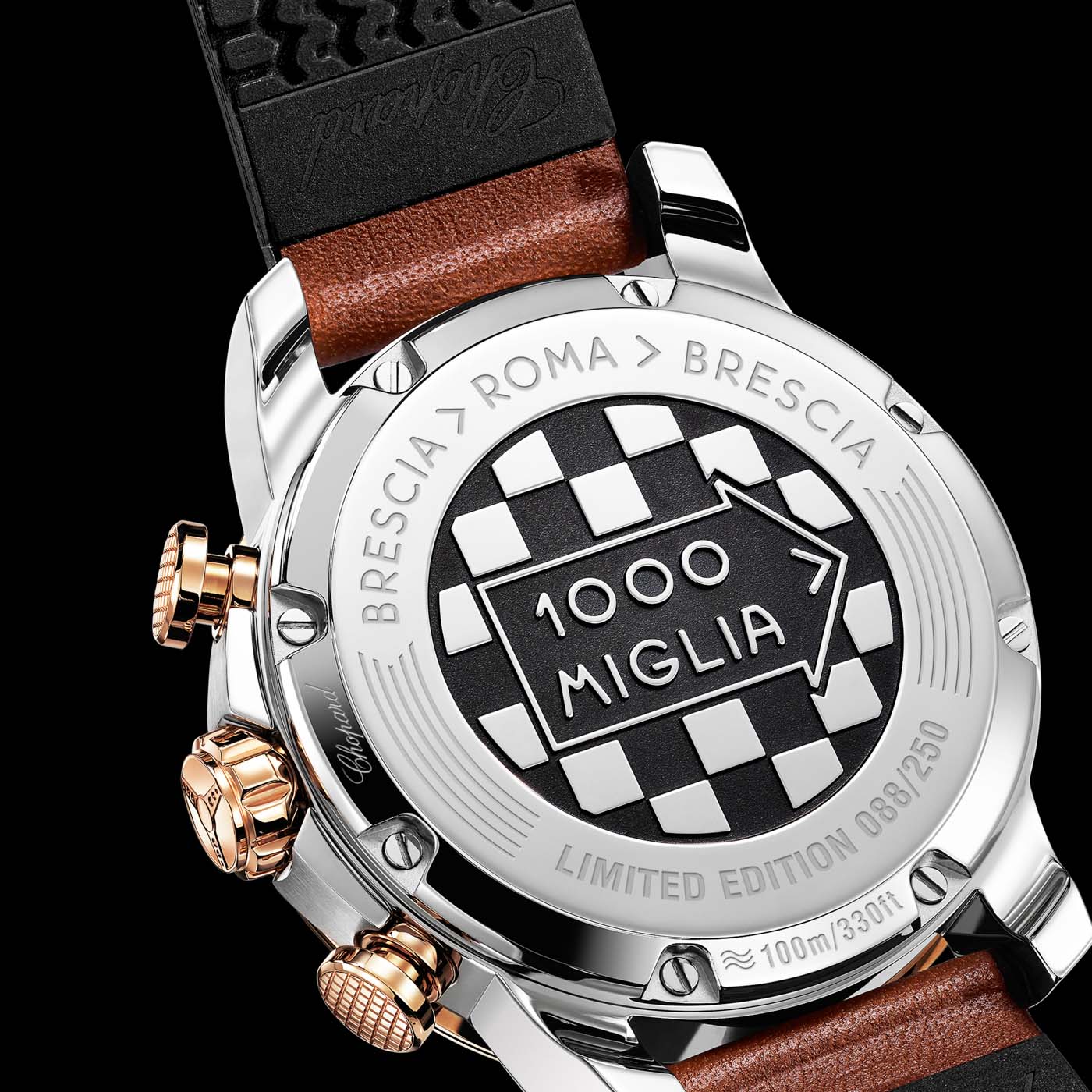
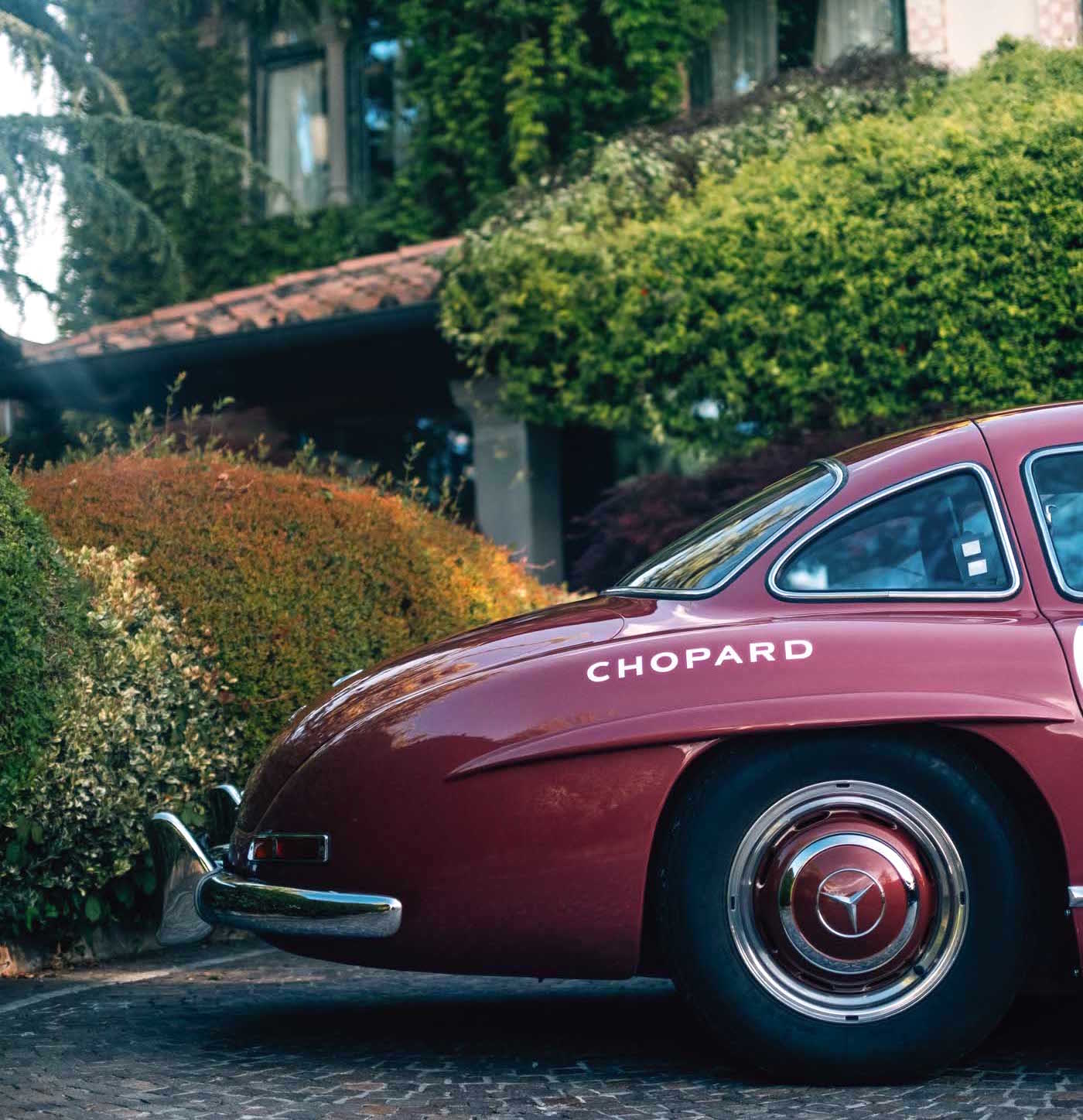
The start was an adventurous one as we were instructed to follow Mr. Scheufele, Chopard’s co–president, driving his pale purple Mercedes Benz Gullwing — the sort of car you normally see in museums, not on the cobbled, often claustrophobic streets of Italian towns or perilous, twisting countryside roads. Anyhow, follow him we did, along with the Chopard fleet of about seven oreight cars. Soon thereafter, I had the distinct sensation of being more or less lost on our way, unable to find the start of the event. After some time of increasingly hectic driving around, we lost track of the 300SL when it performed an overtake I didn’t venture to follow in the 44.6–horsepower Abarth — and that extra .6 horsepower is, I should stress, not a joke. A 60-year-old, 747cc (that is 45.585 cubic inches in America), four-cylinder engine propelled the little Abarth forward — feeling, vibrating and sounding a lot like four Singer sewing machines botched together and splashed in a dash of Castrol (as was clearly indicated on the valve cover).
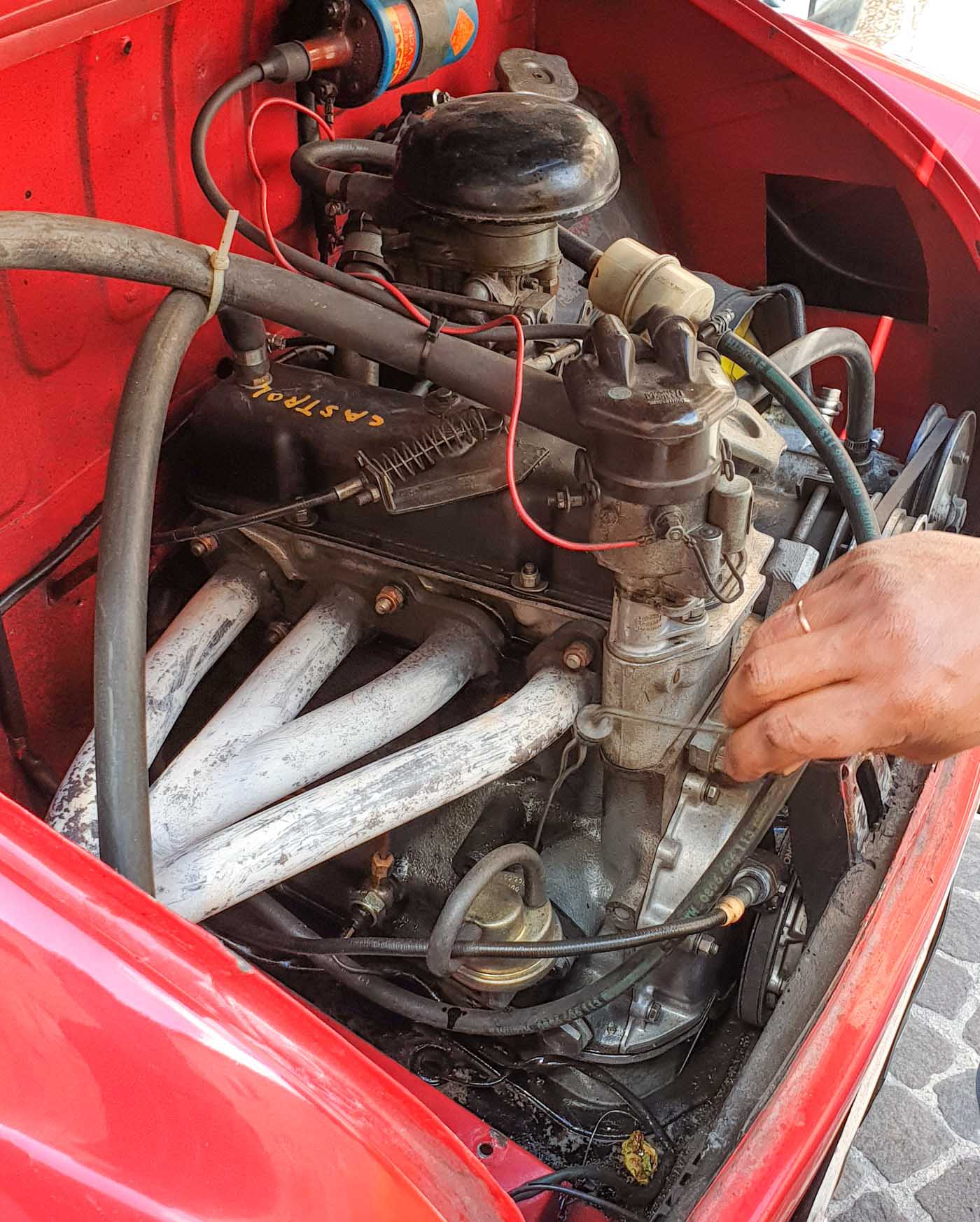
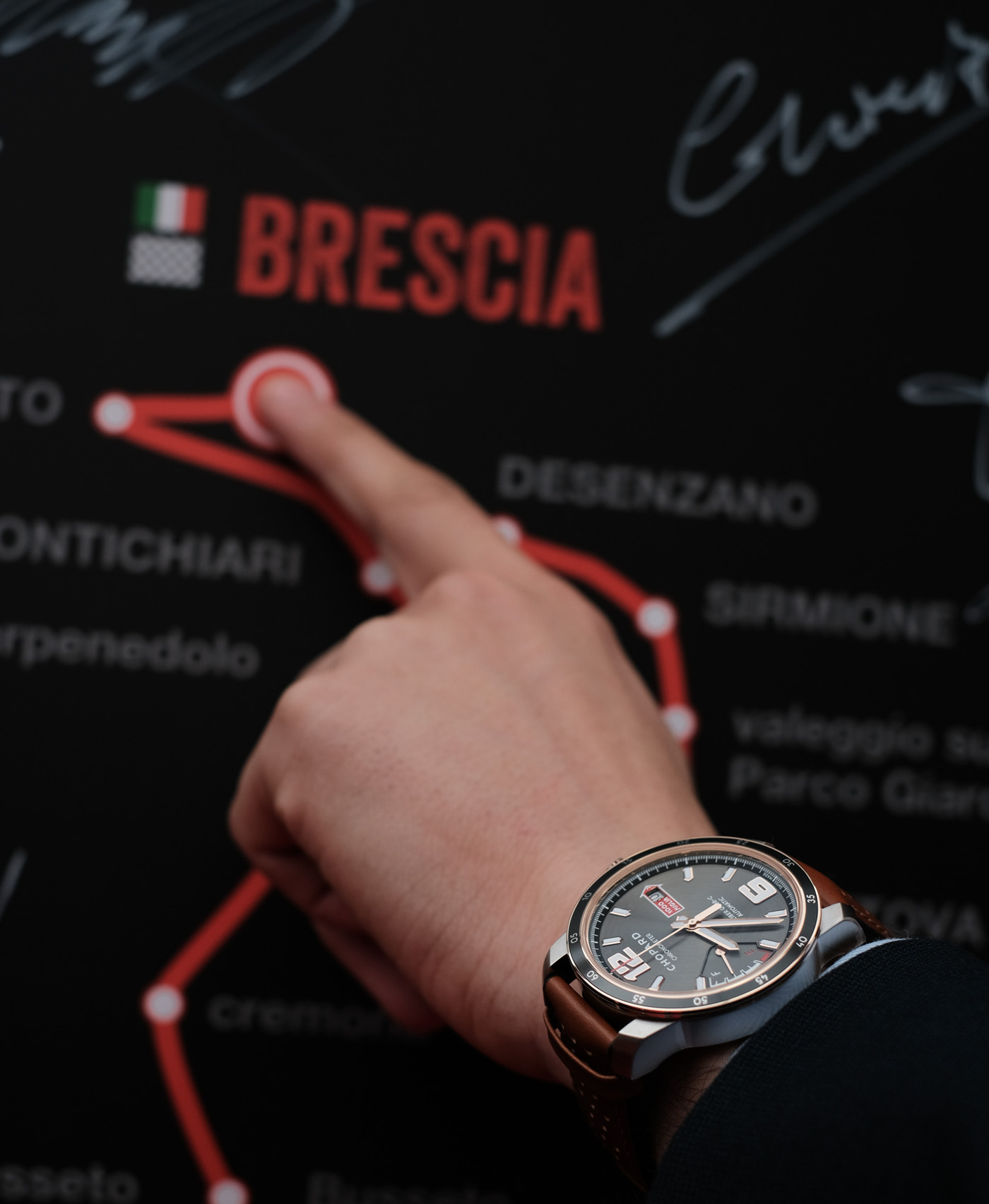
The whole point I am trying to make is that driving these cars is unusually hard, immensely thrilling and, as a result, highly rewarding. It’s not just driving around, though: The same adjectives could be used about navigating a thousand miles on the infamously hectic Italian road network. The route contains closed sections, including roads that lead through an ancient villa’s garden or across some breathtakingly beautiful valleys of Emilia-Romagna, as well as down the public road. Now, in my understanding, because some stages need to be performed as close to a pre-defined time as possible, things can get a bit out of hand if any one of the hundreds of serious participants fighting for the win gets held up. Desperate times call for desperate measures — or so they would in every other country. In Italy, the police rush to their assistance. We were part of such a delayed convoy of cars and witnessed three police bikes quite literally riding into oncoming traffic, with each rider pumping with their arms in the direction of either one of the two sides of the road, hence “asking” the traffic to make a path in the center of the two-lane single carriageway.
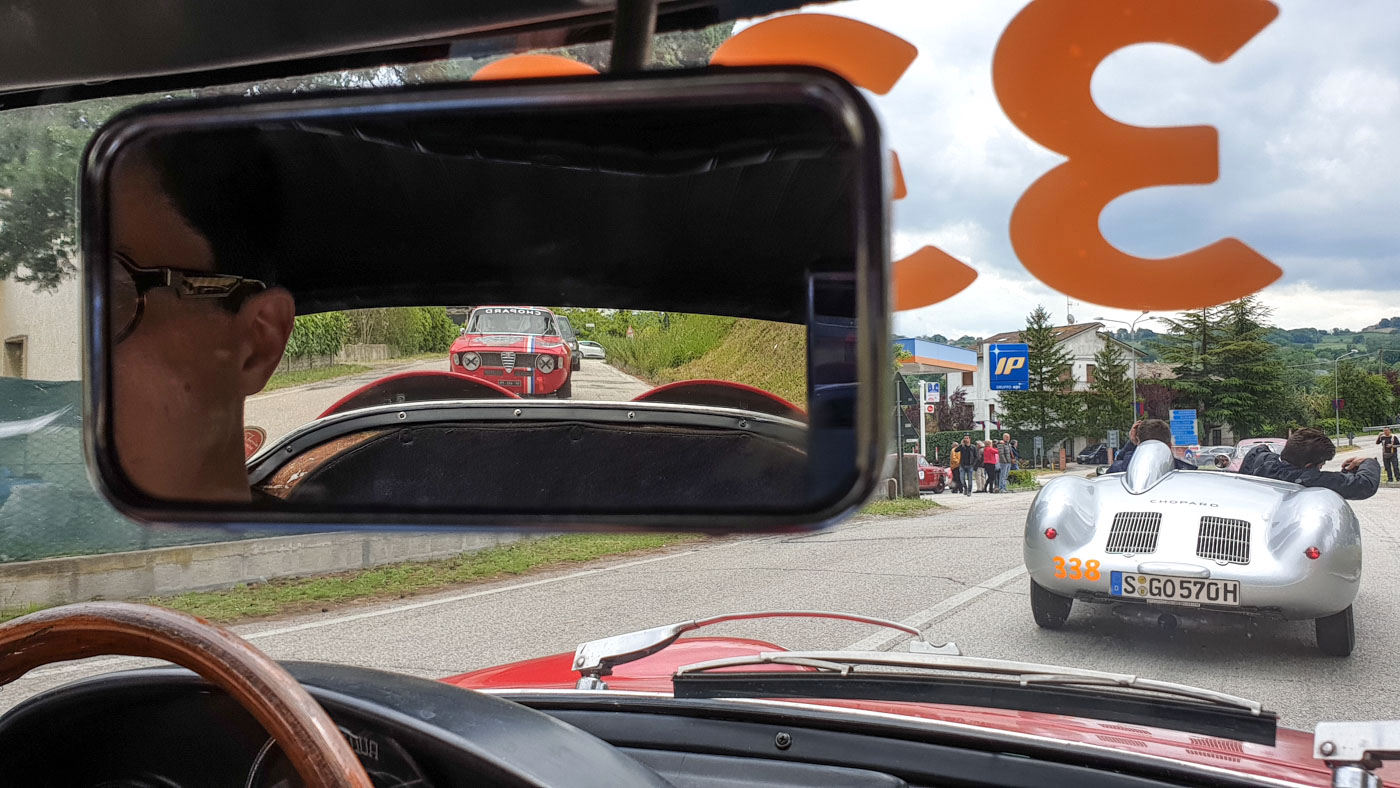
The funky double bubbles and a menacing Alfa Romeo in the rear view mirror, and a borderline priceless Porsche 550 Spider ahead.
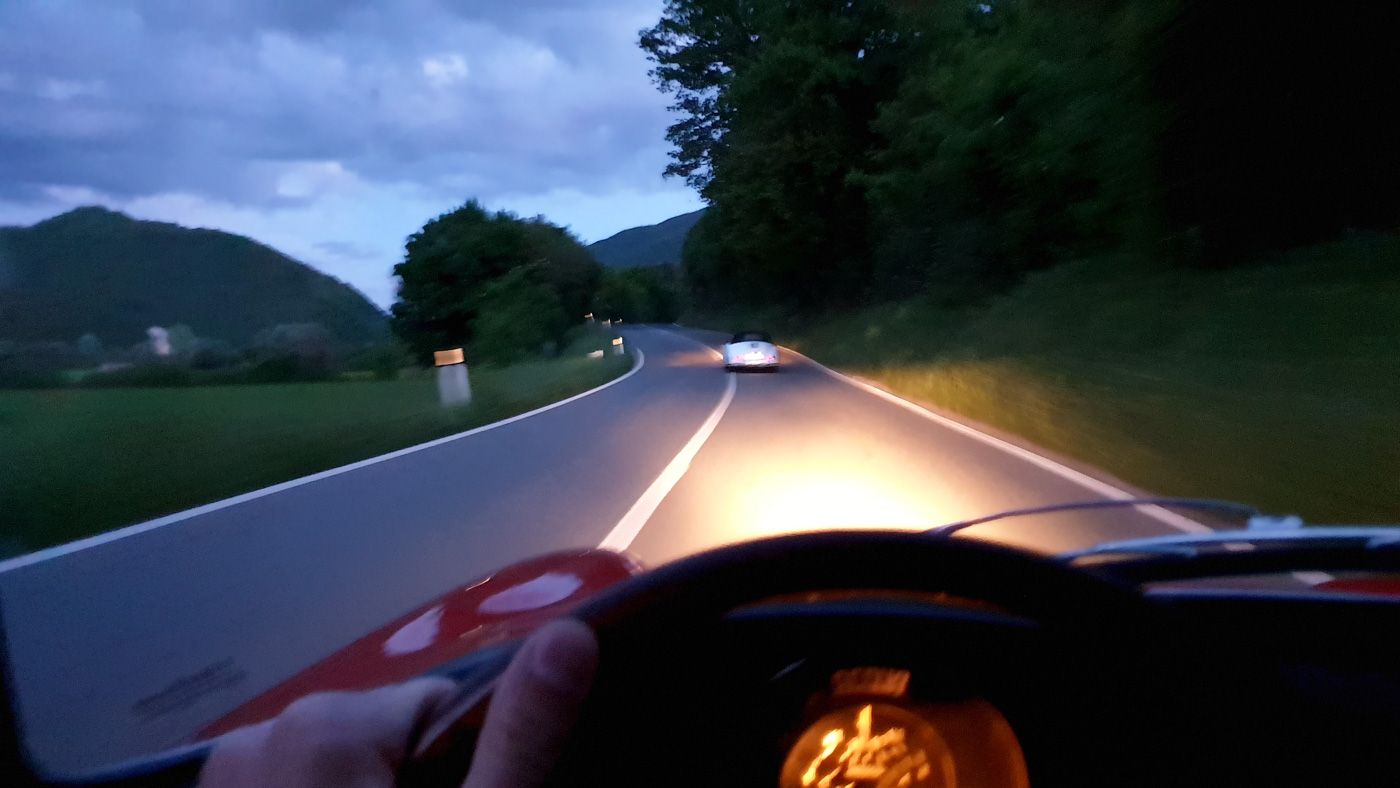
As the road opened, and we were doing about 110kph (65mph) in a zone of 60kph (35mph), the police officers started urging us to drive faster and faster, waving their arms in a rather bossy fashion — and we were only happy to comply. This happened in a train composed of two Gullwings, a Porsche 550 Spider, a 356 Speedster and three other cars I couldn’t easily identify, nor do I remember anything about, I was so busy concentrating on keeping this 44.6HP Double-Bubble part of the train. Needless to say, this was as much of a hair-brained idea as it was an absolute thrill — and the way the traffic assisted us and cheered us along showed just how deeply integrated the love of cars is in Italy. The fact that we overtook an ambulance that had its sirens on because its driver reached out the window and urged us to pass him (and gave us a thumbs-up as we blasted by with our roaring half-a-century-old cars) was well and truly over what I had ever dared to imagine. And when the night finally falls after a full day of driving full of such encounters, one turns onto some abandoned country roads chasing a 356 Speedster in an Abarth 750 — and that’s when, for a brief, passing moment, all is well in the world. Although Mille Miglia and all its crazy moments are a thing of the past, I can still play back just about every scenery and every overtake and situation in my mind like a movie – that’s how genuine this experience has been.
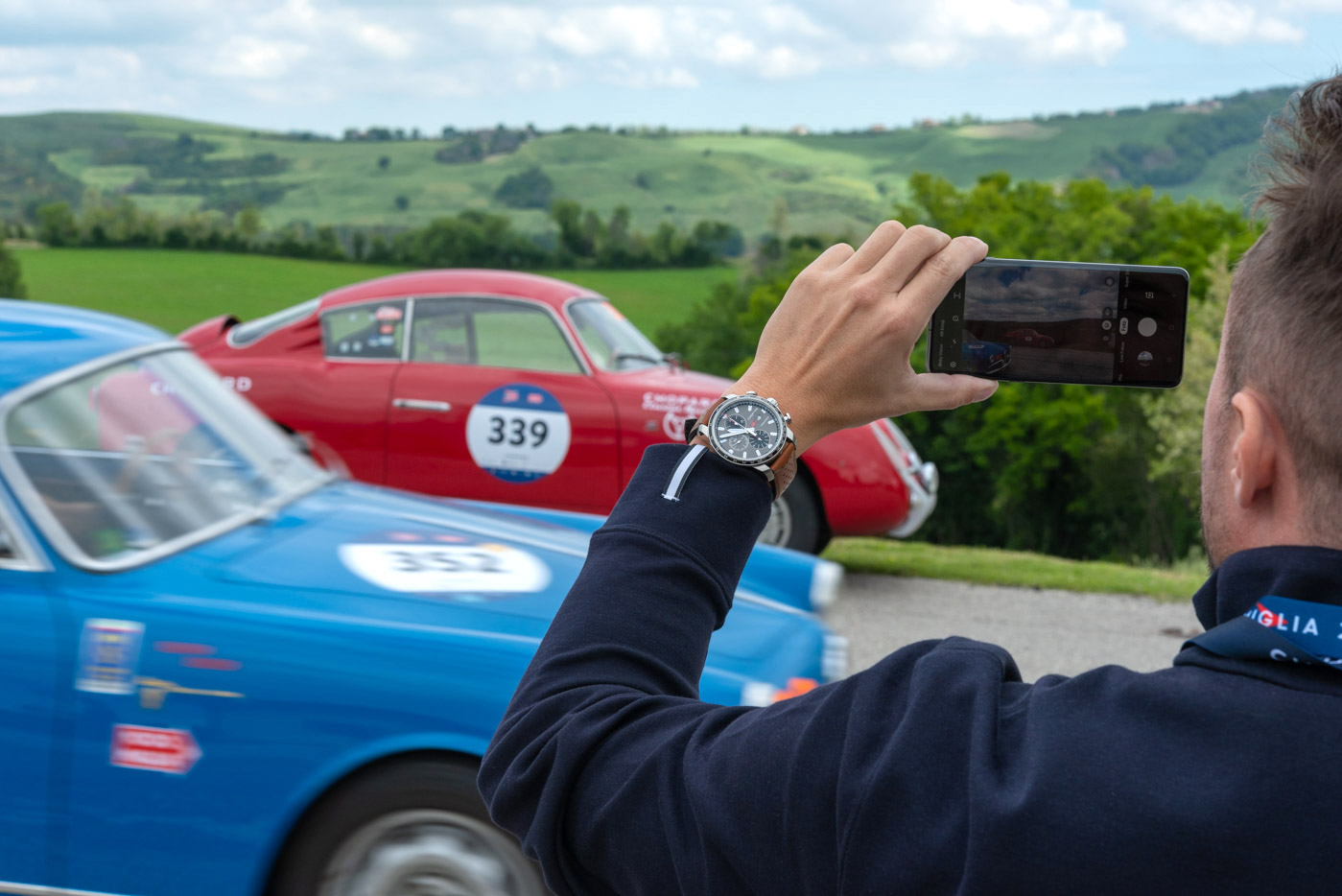
How Does A Watch Go With All This?
I chatted with Mille Miglia participants and learned that they, generally speaking, know and love their cars so much more than they do their watches — which is not the surprising part, at leastfor me. The intriguing element I wanted to unfold and understand a bit more is why they bothered buying and wearing a luxury watch, nevertheless. As I said, watch brands like to cozy up to car companies and car events, but only in a fraction of those cases is a genuine, noteworthy, and special watch born as a result — mostly because they are reduced to slapping a logo on something, as opposed to having their teams involved in helping the watch designers identify what truly matters to that audience that they are so desperately trying to reach.

With its Mille Miglia watches, Chopard first had to overcome the challenge any other brand faces when it designs a watch — as we can tell from the profound shortage of distinctive– and good-looking modern watches, this quite a challenge in itself. Add to this the issue of perseverance: Chopard had to keep standing by this race and, year after year, create a watch that inches closer to paying that much more genuine an homage to the cars and the spirit of the “Most Beautiful Race In The World” — “la corsa più bella del mondo,” as Enzo Ferrari called it.
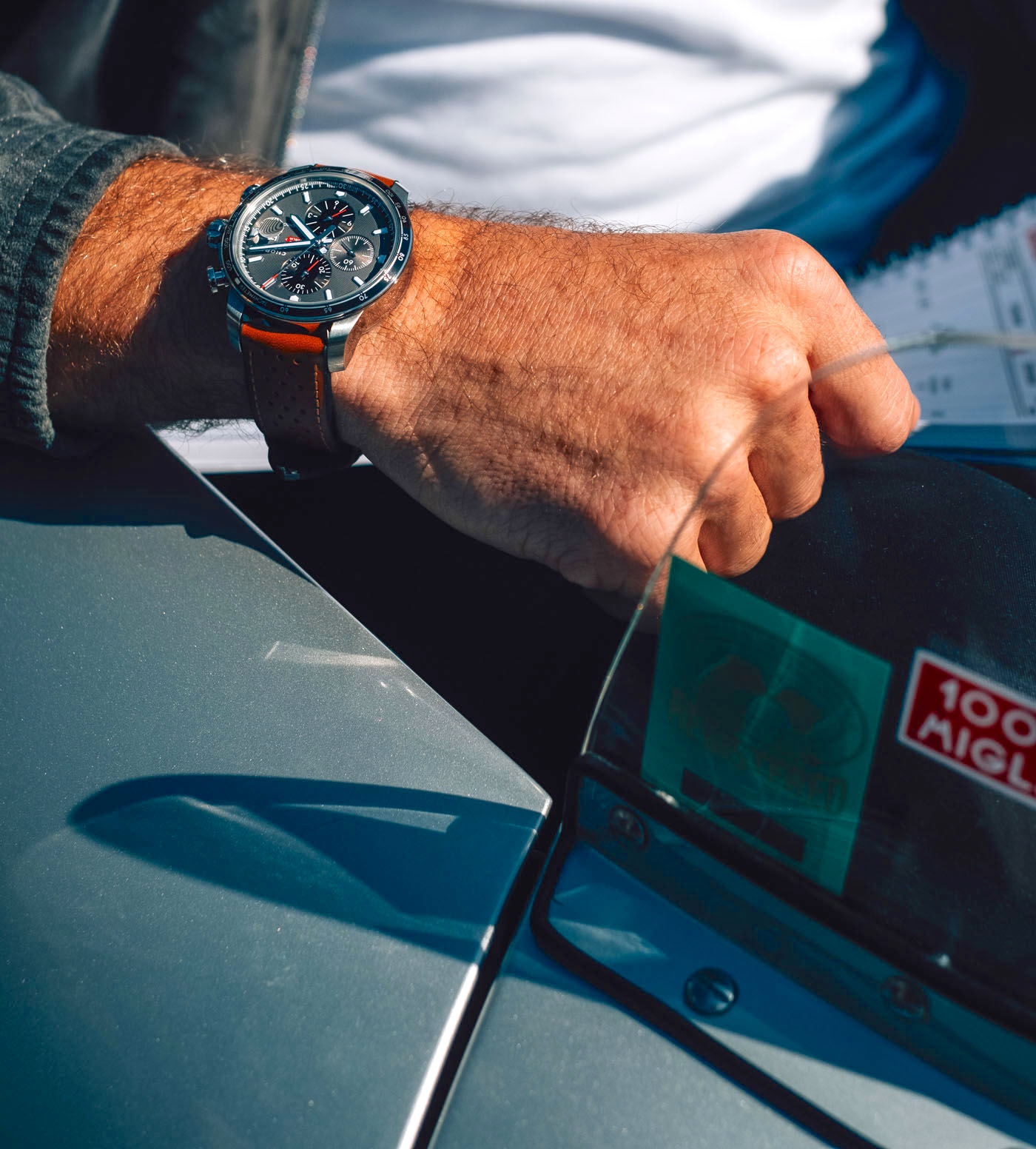
Whether one fancies the different models in the Chopard Mille Miglia collection is down to personal preference — but I doubt their inoffensive looks and good proportions could be argued against. On a personal note, it is one of a handful of collections from which I can choose more than a few watches for myself because I like their designs. But that’s beside the point and so, to understand the lasting success of Mille Miglia watches, we have to return to the title of this article: “Chopard Mille Miglia Is Indeed A True Car-Lovers’ Watch.” Why? Because the primary purpose of a modern luxury watch in the eyes of non-watch-savvy people, I feel it is no stretch to say, is to conserve some great memories that its wearer holds precious, to help communicate something important about its wearer, and to be a legible watch of high enough quality so that even the non-watch-wearer can identify it as a luxury item (beyond its price).
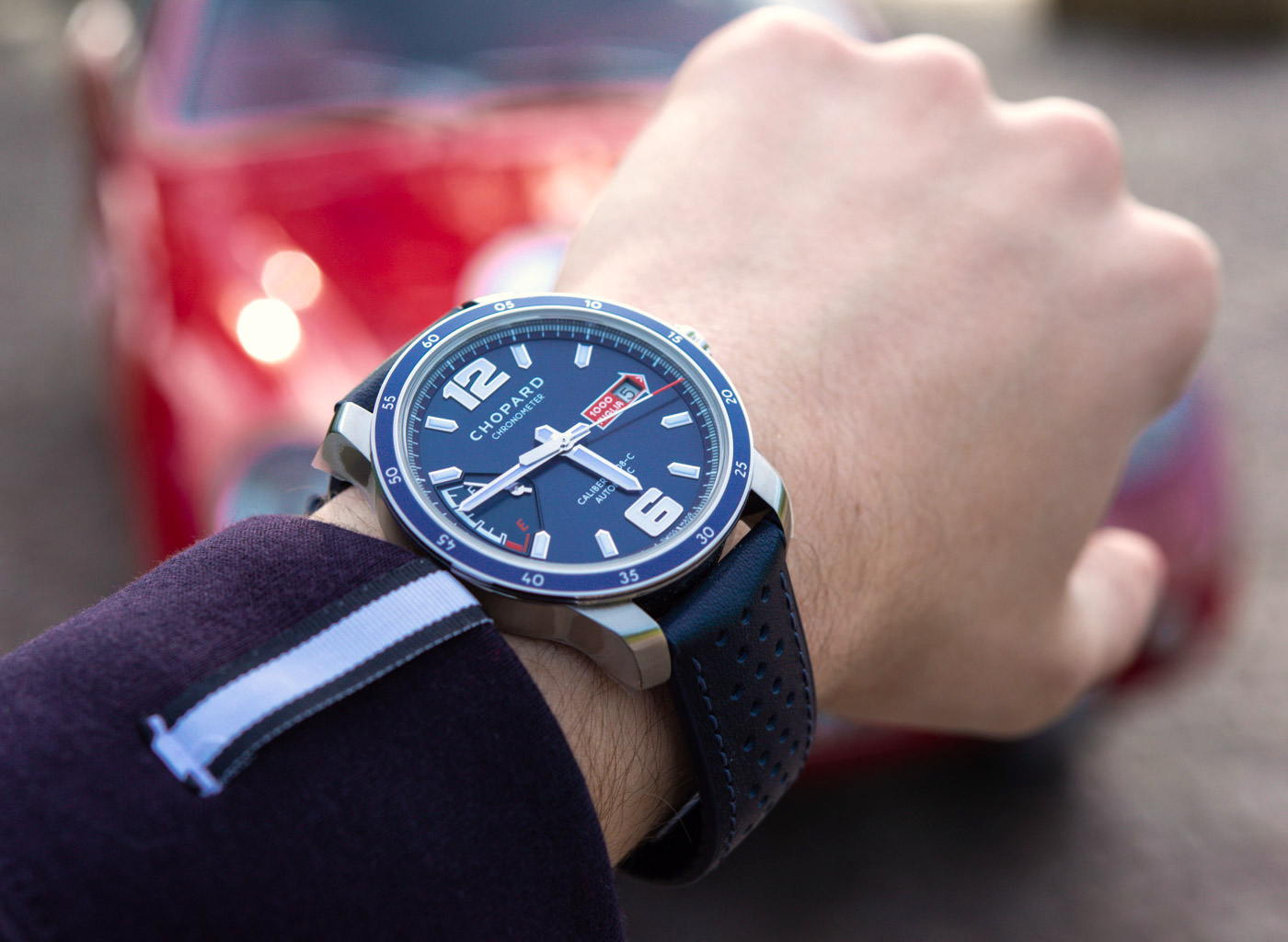
The Chopard Mille Miglia collection is defined by inoffensive, yet distinctive, watches that, first of all, allow their owners to discreetly say to fellow enthusiasts: “Yes, I can tell a flat six from a straight six from a mile away.” As you wear such a watch, you are telling others that you are here for a reason and that you have, in some way, participated in and/or appreciated Mille Miglia and all that stands for.
Every Chopard Mille Miglia watch is dressed in those cute, minute details that mean so much to Mille Miglia participants. Looking at a caseback that says Brescia on it is absolutely meaningless to the majority of the luxury watch buying population — but it means a lot to those privileged who have driven the race, as well as to those car lovers who might not yet have been so fortunate but can identify with what Mille Miglia stands for. And that is not racing, not even speed — but you being among those tens of thousands of others who appreciate “the golden era” of motorcars, either by cheering for them at some point or another of the 1,000-mile stage, or those who have driven the Mille Miglia over the years. And so, these watches are among those few nicely made, yet competitively priced, luxury watches out there that stand not for a car brand, but for an event whose sole purpose is to celebrate and nurture old-school, proper, spirited driving.
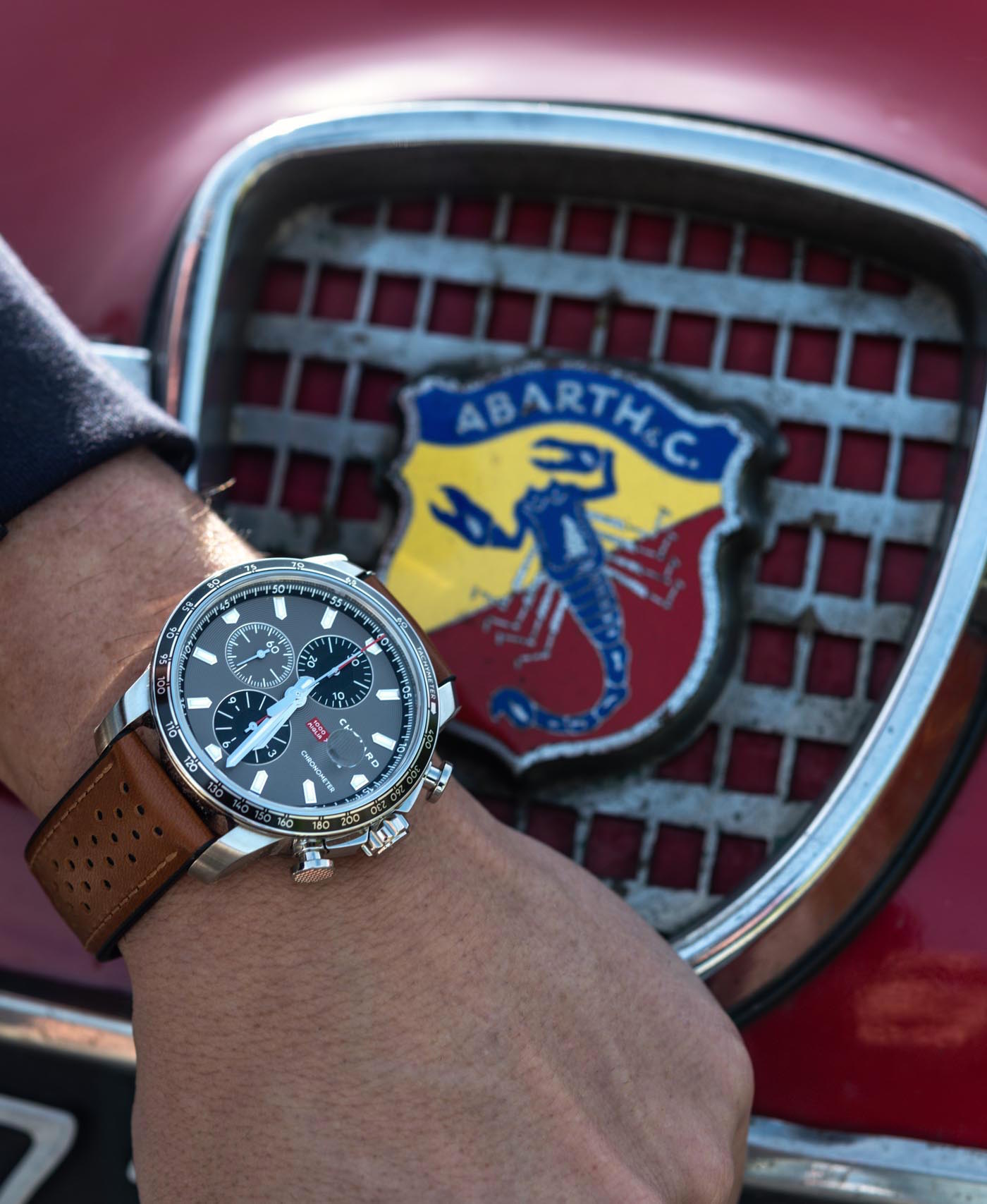
I commend Chopard for having not yet messed up the Mille Miglia collection. It would be all too easy to turn it into a gaudy mess that tries to say more than it possibly could. A 30-odd millimeter-wide watch dial or caseback would never be able to tell the story of a thousand miles. But it can — and does — successfully evoke the best memories when the wait is at its longest until the next Mille Miglia. Visit chopard.com to learn more.

